Attached files
| file | filename |
|---|---|
| 8-K - FORM 8-K - DITECH HOLDING Corp | c17625e8vk.htm |
| EX-99.2 - EXHIBIT 99.2 - DITECH HOLDING Corp | c17625exv99w2.htm |
Exhibit 99.1
INFORMATION MEMORANDUM

$500,000,000 FIRST LIEN TERM LOAN
$265,000,000 SECOND LIEN TERM LOAN
$265,000,000 SECOND LIEN TERM LOAN
Public Version
May 2011

|

|

|
 |
|||
| JOINT LEAD ARRANGER | JOINT LEAD ARRANGER | JOINT BOOKRUNNER | CO-DOCUMENTATION | |||
| JOINT BOOKRUNNER | JOINT BOOKRUNNER | CO-DOCUMENTATION | AGENT | |||
| ADMINISTRATIVE AGENT | SYNDICATION AGENT | AGENT |
SPECIAL NOTICE REGARDING PUBLICLY AVAILABLE INFORMATION
THE COMPANY HAS REPRESENTED THAT THE INFORMATION CONTAINED IN THIS INFORMATION MEMORANDUM IS
EITHER (i) PUBLICLY AVAILABLE OR (ii) NOT MATERIAL WITH RESPECT TO THE COMPANY OR ITS SUBSIDIARIES
OR ANY OF ITS OR THEIR RESPECTIVE SECURITIES FOR PURPOSES OF FOREIGN, UNITED STATES FEDERAL AND
STATE SECURITIES LAWS. THE RECIPIENT OF THIS INFORMATION MEMORANDUM HAS STATED THAT IT DOES NOT
WISH TO RECEIVE MATERIAL NON-PUBLIC INFORMATION WITH RESPECT TO THE COMPANY OR ITS SECURITIES AND
ACKNOWLEDGES THAT OTHER LENDERS HAVE RECEIVED AN INFORMATION MEMORANDUM THAT CONTAINS ADDITIONAL
INFORMATION WITH RESPECT TO THE COMPANY OR ITS SECURITIES THAT MAY BE MATERIAL. NEITHER THE COMPANY
NOR THE ARRANGERS TAKE ANY RESPONSIBILITY FOR THE RECIPIENT’S DECISION TO LIMIT THE SCOPE OF THE
INFORMATION IT HAS OBTAINED IN CONNECTION WITH ITS EVALUATION OF THE COMPANY AND THE FACILITIES.
Table of Contents
1. Administrative information |
2 | |||
2. Executive summary |
5 | |||
3. Key credit highlights |
14 | |||
4. Industry overview |
25 | |||
5. Walter overview |
36 | |||
6. Green Tree overview |
44 | |||
7. Management team |
71 | |||
8. Historical financial results |
75 |

|
Page 1 of 90 |
1. Administrative information

|
Page 2 of 90 |
1. Administrative information
A. Notice to and undertaking by recipients
This Information Memorandum (the “Information Memorandum”) has been prepared solely for
informational purposes from information supplied by or on behalf of Walter Investment Management
Corp. (the “Company”), and is being furnished by Credit Suisse Securities (USA) LLC and RBS
Securities Inc. (each, an “Arranger” and collectively, the “Arrangers”) to you in your capacity as
a prospective lender (the “Recipient”) in considering the proposed Credit Facilities described in
the Information Memorandum (each, a “Facility” and collectively, the “Facilities”).
ACCEPTANCE OF THIS INFORMATION MEMORANDUM CONSTITUTES AN AGREEMENT TO BE BOUND BY THE TERMS OF THIS
NOTICE AND UNDERTAKING (THIS “NOTICE AND UNDERTAKING”) AND THE SPECIAL NOTICE
SET FORTH ON THE COVER PAGE HEREOF (THE “SPECIAL NOTICE”). IF THE RECIPIENT IS NOT WILLING TO
ACCEPT THE INFORMATION MEMORANDUM AND OTHER EVALUATION MATERIAL (AS DEFINED HEREIN) ON THE TERMS
SET FORTH IN THIS NOTICE AND UNDERTAKING AND THE SPECIAL NOTICE, IT MUST RETURN THE INFORMATION
MEMORANDUM AND ANY OTHER EVALUATION MATERIAL TO THE ARRANGERS IMMEDIATELY WITHOUT MAKING ANY COPIES
THEREOF, EXTRACTS THEREFROM OR USE THEREOF.
As used herein: (a) “Evaluation Material” refers to this Information Memorandum and any other
information regarding the Company or the Facilities furnished or communicated to the Recipient by
or on behalf of the Company in connection with any Facility (whether prepared or communicated by
the Arrangers or the Company, their respective advisors or otherwise) and (b) “Internal Evaluation
Material” refers to all memoranda, notes, and other documents and analyses developed by the
Recipient using any of the information specified under the definition of Evaluation Material.
I. Information
The Recipient acknowledges and agrees that (i) the Arranger received the Evaluation Material
from third party sources (including the Company) and it is provided to the Recipient for
informational purposes, (ii) the Arrangers and their affiliates bear no responsibility (and shall
not be liable) for the accuracy or completeness (or lack thereof) of the Evaluation Material or any
information contained therein, (iii) no representation regarding the Evaluation Material is made by
the Arrangers or any of their affiliates, (iv) neither the Arrangers nor any of their affiliates
have made any independent verification as to the accuracy or completeness of the Evaluation
Material, and (v) the Arrangers and their affiliates shall have no obligation to update or
supplement any Evaluation Material or otherwise provide additional information.
The Evaluation Material has been prepared to assist interested parties in making their own
evaluation of the Company and the Facilities and does not purport to be all-inclusive or to contain
all of the information that a prospective participant may consider material or desirable in making
its decision to become a lender. The Recipient should take such steps as it deems necessary to
assure that it has the information it considers material or desirable in making its decision to
become a lender and should perform its own independent investigation and analysis of the Facilities
or the transactions contemplated thereby and the creditworthiness of the Company. The Recipient
represents that it is sophisticated and experienced in extending credit to entities similar to the
Company. The information and data contained herein are not a substitute for the Recipient’s
independent evaluation and analysis and should not be considered as a recommendation by the
Arrangers or any of their affiliates that any Recipient enters into any Facility.

|
Page 3 of 90 |
The Evaluation Material may include certain forward looking statements and projections provided by
the Company. Any such statements and projections reflect various estimates and assumptions by the
Company concerning anticipated results. No representations or warranties are made by the Company,
the Arrangers or any of their respective affiliates as to the accuracy of any such statements or
projections. Whether or not any such forward looking statements or projections are in fact
achieved will depend upon future events some of which are not within the control of the Company.
Accordingly, actual results may vary from the projected results and such variations may be
material. Statements contained herein describing documents and agreements are summaries only and
such summaries are qualified in their entirety by reference to such documents and agreements.
II. General
It is understood that unless and until a definitive agreement regarding the applicable
Facility between the parties thereto has been executed, the Recipient will be under no legal
obligation of any kind whatsoever with respect to such Facility by virtue of this Notice and
Undertaking except for the matters specifically agreed to herein and in the Special Notice.
The Recipient agrees that money damages would not be a sufficient remedy for breach of this Notice
and Undertaking or of the Special Notice, and that in addition to all other remedies available at
law or in equity, the Company and the Arrangers shall be entitled to equitable relief, including
injunction and specific performance, without proof of actual damages.
This Notice and Undertaking and the Special Notice together embody the entire understanding and
agreement between the Recipient and the Arrangers with respect to the Evaluation Material and the
Internal Evaluation Material and supersede all prior understandings and agreements relating
thereto. The terms and conditions of this Notice and Undertaking and the Special Notice shall
apply until such time, if any, that the Recipient becomes a party to the definitive agreements
regarding the applicable Facility, and thereafter the provisions of such definitive agreements
shall govern. If you do not enter into any Facility, the application of this Notice and
Undertaking and the Special Notice shall terminate with respect to all Evaluation Material and
Internal Evaluation Material on the date falling two years after the date of the Information
Memorandum.
This Notice and Undertaking and the Special Notice shall be governed by and construed in accordance
with the law of the State of New York, without regard to principles of conflicts of law (except
Section 5-1401 of the New York General Obligations Law to the extent that it mandates that the law
of the State of New York govern).

|
Page 4 of 90 |
2. Executive summary

|
Page 5 of 90 |
2. Executive summary
A. Transaction overview
Based in Tampa, Florida, Walter Investment Management Corp. (“Walter” or the “Company”) is a
high-touch, relationship-based owner and servicer of credit-sensitive consumer real estate loans
utilizing a primarily de-centralized servicing model. As of March 31, 2011, Walter serviced a
total outstanding unpaid principal balance (“UPB”) of $1.8 billion. With 336 employees and 70
offices located in 14 states, Walter’s field servicing handles collections of loans 30+ days
delinquent and loss mitigation functions.
Founded in 1958, Walter and its predecessors have been portfolio originators, owners and servicers
for over 50 years. Walter (NYSE Amex: WAC) currently has a market capitalization of $468 million
(as of 5/16/11).
On March 28, 2011, Walter announced that it had entered into a definitive agreement to purchase
GTCS Holdings LLC (“Green Tree”) for a total purchase price of approximately $1,065 million
including approximately 1.8 million shares of Walter common stock (the “Acquisition”). Green Tree
is a fee-based business services company that provides high-touch, third-party servicing for
credit-sensitive consumer loans in diverse asset classes, including residential mortgages,
manufactured housing (“MH”) and consumer installment loans. As of March 31, 2011, Green Tree
serviced a loan portfolio with UPB of $36.6 billion, and is one of the leading independent
servicers in the U.S. Green Tree operates a high-touch, borrower-centric servicing model with
limited advance obligations, and has 1,924 employees in 31 offices across the U.S.
The Acquisition will be financed with $765 million of debt consisting of a $500 million first lien
term loan and a $265 million second lien term loan. The transaction is expected to close in Q3
2011.
Walter has retained Credit Suisse Securities (USA) LLC (“Credit Suisse Securities”) and RBS
Securities Inc. (“RBS Securities”) to arrange a $45 million Senior Secured Revolving Credit
Facility (the “Revolving Facility”), a $500 million First Lien Senior Secured Term Loan (the “First
Lien Term Loan”), and a $265 million Second Lien Senior Secured Term Loan (the “Second Lien Term
Loan” and, together with the Revolving Credit Facility and the First Lien Term Loan, the “Senior
Credit Facilities”). Credit Suisse AG is acting as the sole administrative agent (the “Admin
Agent”) for the Senior Credit Facilities. Credit Suisse Securities, RBS Securities, and Merrill
Lynch, Pierce, Fenner & Smith Incorporated are acting as joint bookrunners. The Royal Bank of
Scotland plc is acting as syndication agent. Merrill Lynch, Pierce, Fenner & Smith Incorporated
and Morgan Stanley Senior Funding, Inc. are acting as co-documentation agents.
The Company will also use balance sheet cash, monetize certain unencumbered assets and owned bonds,
and issue approximately 1.8 million shares of common stock to the seller (approximately 6.4% of
Walter’s outstanding common stock on a fully diluted basis) to make up the balance of the purchase
price and transaction costs. The proceeds will be used to (i) repay Green Tree’s existing term
loan, (ii) fund the purchase price of the Acquisition, (iii) pay fees and expenses associated with
the transaction, and (iv) provide funds for ongoing working capital needs and general corporate
purposes.

|
Page 6 of 90 |
B. Sources and uses of funds


|
Page 7 of 90 |
C. Pro forma capitalization
($ in millions)
| As of 3/31/11A | Cum. EBITDA | |||||||||||||||||||
| Walter | Green Tree | Adjustments | Combined | multiple | ||||||||||||||||
Unrestricted cash (1) |
$ | 58.4 | $ | 73.2 | $ | (115.2 | ) | $ | 16.4 | |||||||||||
Corporate debt (2) |
||||||||||||||||||||
MSR acquisition facility (3) |
— | $ | 17.5 | — | $ | 17.5 | 0.07x | |||||||||||||
Senior secured credit facility |
— | 294.7 | (294.7 | ) | — | 0.07x | ||||||||||||||
Revolver (4) |
— | — | — | — | 0.07x | |||||||||||||||
First Lien Term Loan |
— | — | 500.0 | 500.0 | 2.22x | |||||||||||||||
Second Lien Term Loan |
— | — | 265.0 | 265.0 | 3.35x | |||||||||||||||
Total corporate debt |
— | $ | 312.2 | $ | 470.3 | $ | 782.5 | 3.35x | ||||||||||||
Non-recourse debt |
||||||||||||||||||||
Servicer advance facility (5) |
— | $ | 55.0 | — | $ | 55.0 | ||||||||||||||
Mortgage related debt (6) |
1,260.5 | 831.3 | 222.8 | 2,314.6 | ||||||||||||||||
Total debt |
$ | 1,260.5 | $ | 1,198.5 | $ | 693.1 | $ | 3,152.1 | ||||||||||||
Stockholders’ equity |
559.5 | 81.4 | (131.2 | ) | 509.7 | |||||||||||||||
Total capitalization |
$ | 1,820.0 | $ | 1,279.9 | $ | 561.9 | $ | 3,661.8 | ||||||||||||
Operating statistics (LTM 3/31/11) |
||||||||||||||||||||
Walter adj. EBITDA before synergies |
$ | 39.9 | — | — | $ | 39.9 | ||||||||||||||
Green Tree adj. EBITDA |
— | 174.7 | — | 174.7 | ||||||||||||||||
Synergies |
— | — | 19.0 | 19.0 | ||||||||||||||||
Adjusted EBITDA (7) |
$ | 39.9 | $ | 174.7 | $ | 19.0 | $ | 233.6 | ||||||||||||
Credit statistics |
||||||||||||||||||||
Corporate debt / EBITDA |
NM | 1.79x | 3.35x | |||||||||||||||||
EBITDA / corp. debt interest expense (8) |
NM | 6.24x | 3.74x | |||||||||||||||||
| (1) | Adjustments include $43 million distribution from Green Tree to its current shareholders
plus $72 million in transaction-related uses of cash. |
|
| (2) | Corporate debt adjustments are reported at the face amount. |
|
| (3) | Green Tree’s MSR financing facility is a limited recourse facility to fund an MSR acquisition
secured by servicing rights acquired as well as associated servicing revenue streams earned. |
|
| (4) | $45mm facility. |
|
| (5) | Green Tree’s servicer advance facility is a non-recourse facility fully collateralized by the
outstanding servicing advances. |
|
| (6) | Mortgage related debt is non-recourse debt consolidated under FAS 167. Green Tree’s debt is
recorded at fair value. Walter’s debt is recorded at face amount net of discounts. |
|
| (7) | Adjusted EBITDA does not reflect the deduction of a full year of principal and interest
totaling approximately $23.1 million related to Walter’s 2010-1 securitization. |
|
| (8) | Interest associated with corporate debt only. |

|
Page 8 of 90 |
D. Organizational structure
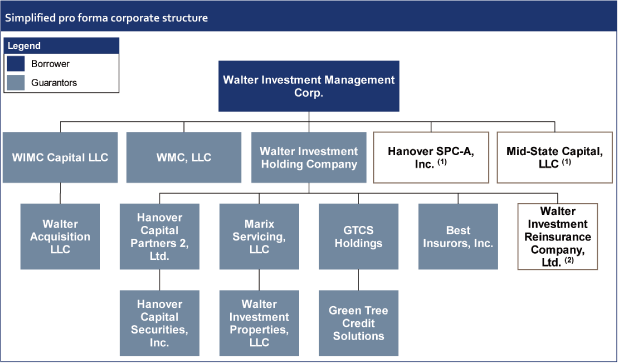
| (1) | Securitization trusts — residual cash flows are owned by Walter Investment Management
Corp. (the Borrower) and represent 20.9% of pro forma LTM 3/31/11 EBITDA. |
|
| (2) | Represents less than 2% of pro forma LTM 3/31/11 EBITDA. |

|
Page 9 of 90 |
E. Summary terms for the Facilities
| Senior Secured Revolving | First Lien Senior Secured | Second Lien Senior Secured | ||||
| Credit Facility | Term Loan | Term Loan | ||||
| Borrower: | Walter Investment Management Corp. (the “Borrower”) |
|||||
Amount:
|
$45 million | $500 million | $265 million | |||
Maturity:
|
Earlier of 5 years after closing date and June 30, 2016 | Earlier of 5 years after closing date and June 30, 2016 | Earlier of 5.5 years after closing date and December 31, 2016 | |||
Interest rate:
|
LIBOR + 525 bps | LIBOR + 525 bps | LIBOR + 900 bps | |||
LIBOR floor:
|
150 bps | 150 bps | 150 bps | |||
Upfront / OID:
|
99% of par | 99% of par | 99% of par | |||
Commitment fee:
|
75 bps | NA | NA | |||
Mandatory amortization:
|
NA | 2.5% per quarter; remainder on final maturity | None (bullet maturity) | |||
Security:
|
First priority pledge on substantially all assets of the Borrower and guarantors (with certain exclusions) | First priority pledge on substantially all assets of the Borrower and guarantors (with certain exclusions) | Second priority pledge on substantially all assets of the Borrower and guarantors (with certain exclusions) | |||
Optional redemptions:
|
NA | 101 soft call (applies to prepayments in connection with repricing transactions only occurring on or before the first anniversary of the closing date and par thereafter) | 103% in year 1 / 102% in year 2 / 101% in year 3 / par thereafter | |||
Affirmative covenants:
|
Customary for facilities of this type | Customary for facilities of this type | Customary for facilities of this type | |||
Negative covenants:
|
Customary for facilities of this type, including: | Customary for facilities of this type, including: | Customary for facilities of this type, including: | |||
• Limitations on Restricted Payments
|
• Limitations on Restricted Payments
|
• Limitations on Restricted Payments |
||||
• Limitations on Indebtedness
|
• Limitations on Indebtedness
|
• Limitations on Indebtedness |
||||
• Limitations on Capital Expenditures
|
• Limitations on Capital Expenditures
|
• Limitations on Capital Expenditures |
||||
• Limitations on Liens
|
• Limitations on Liens
|
• Limitations on Liens |
||||
• Limitations on Asset Sales
|
• Limitations on Asset Sales
|
• Limitations on Asset Sales |
||||
Financial covenants:
|
Maintenance covenants: | Maintenance covenants: | Maintenance covenants: | |||
• Total debt / EBITDA
|
• Total debt / EBITDA
|
• Total debt / EBITDA |
||||
• EBITDA / Interest expense
|
• EBITDA / Interest expense
|
• EBITDA / Interest expense |
||||

|
Page 10 of 90 |
F. Company overview
Walter
Based in Tampa, Florida, Walter Investment Management Corp. (NYSE Amex: WAC) is a high-touch,
relationship-based owner and servicer of credit-sensitive consumer real estate loans utilizing a
primarily de-centralized servicing model. As of March 31, 2011, Walter serviced a portfolio with a
total outstanding UPB of $1.8 billion, consisting of 33,794 owned accounts and an additional 6,114
accounts serviced for third parties. With 336 employees and 70 offices located in 14 states,
Walter’s field servicing handles collections of loans 30+ days delinquent and loss mitigation
functions.
Founded in 1958, Walter and its predecessors have been portfolio originators, owners and servicers
for over 50 years. Originally part of Walter Industries, Walter Investment was spun off and merged
with Hanover Capital, a publicly traded mortgage REIT, in 2009, and began trading under the ticker
“WAC.” Subsequent to its spinoff, Walter completed an $82 million follow-on offering of common
stock and currently has a market capitalization of $468 million (as of 5/16/11). In November 2010,
Walter completed the purchase of Marix Servicing, giving it a nationwide servicing capability.
Walter has been a highly successful repeat issuer of securitizations rated by S&P and Moody’s, with
$1.3 billion (95%) of its outstanding RMBS bonds currently rated investment grade by one of the
agencies.
Green Tree
Green Tree is a fee-based business services company that provides high-touch third-party servicing
for credit-sensitive consumer loans in diverse asset classes, including residential mortgages,
manufactured housing (“MH”) and consumer installment loans. One of the leading independent
mortgage servicers in the U.S., Green Tree services a loan portfolio with a UPB of $36.6 billion as
of March 31, 2011, consisting of approximately 738,440 loans, and operates a high-touch,
borrower-centric servicing model with limited advance obligations. Green Tree has 1,924 employees
in 31 offices across the U.S., which makes them ideally suited for managing credit-sensitive
assets.
Green Tree’s mortgage servicing platform is highly rated by Moody’s, S&P and Fitch, and is one of
the few to have received upgrades from the rating agencies in the past year.
Green Tree’s business strategy is to provide services to generate diversified, high-margin,
fee-based earnings with negligible credit risk:
| • | Growing its core third-party servicing product to provide servicing for credit-sensitive consumer assets, including
residential mortgages, MH and consumer installment loans |
|
| • | Leveraging the platform to offer complementary products to a captive customer base, as well as new customers that
generate high-margin, fee-based recurring revenue streams with minimal capital requirements |
|
| • | Demonstrating its ability to service multiple asset classes both within the mortgage space and across various consumer
products |
|
| • | Generating diversified, high margin, fee-based recurring revenue streams that produce significant free cash flow |
|
| • | Minimizing servicer advance obligations, which is in stark contrast to the rest of the industry and limits the need for
capital outlay |

|
Page 11 of 90 |
Compelling strategic rationale
The Acquisition will transform Walter into a premier fee-based business services company providing
high-touch, third-party servicing of credit-sensitive consumer loans from an asset light platform.
Going forward, the combined company intends to focus its efforts on Green Tree’s asset-light,
fee-based servicing opportunities and investment management business, where it believes the
risk-reward proposition is most attractive. Walter will be well positioned to take advantage of
attractive sector trends, such as the continued high level of distressed mortgage assets and
increasing flows of these assets away from traditional servicers and towards special servicers.
Walter intends to allow its existing mortgage portfolio investments to run off, generating
significant cash flow to de-lever the Company and to fund attractive growth opportunities.
Post-transaction, Walter will no longer qualify as a REIT, and intends to pay a nominal dividend.
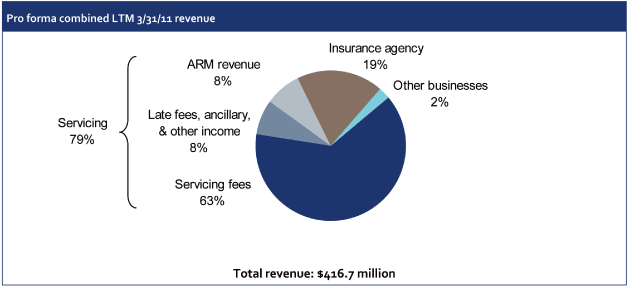
Note:Total revenue does not include residual cash flows of $48.9 million.
The two companies are a very solid fit:
| • | Similar business models with long, established track records of producing industry-leading servicing results |
|
| • | Experienced management teams with significant company and industry tenure and similar operating approaches
focused on creating shareholder value |
|
| • | Ability to leverage platforms and achieve cost and revenue synergies |
|
| • | Positioned to take advantage of attractive sector trends |
|
| • | Enhanced size and scale to better compete on a nationwide basis |
The Acquisition presents minimal integration risk. The majority of synergies will be derived from
removing costs from overlapping servicing platforms and shared services. Post-transaction, the
highly experienced management teams of both Walter and Green Tree will remain with the Company.
Walter management will remain in Tampa and will be responsible for public company functions, the
Walter portfolios, strategy, corporate development, and assistance to and oversight of Green Tree.
Green Tree’s management will remain with the Company and continue to run Green Tree’s operations
from Green Tree’s headquarters in St. Paul, MN. Brian Libman, CEO of Green Tree, will assume the
title of Chief Strategic Officer of the combined company.

|
Page 12 of 90 |
G. Key credit highlights
Attractive
business model
with multiple
stable and
complementary cash
flow streams
|
• • • • • |
Fee-for-service model High margins and strong free cash flow conversion with minimal capital expenditures Diversified revenue streams from complementary businesses Minimal credit or liquidity risk Licensing, servicer ratings, technology infrastructure and proprietary servicing models create substantial barriers to entry |
||
Best in-class servicer with differentiated, high-touch approach |
• • • |
Best-in-class servicer • “High touch” servicing model suited to maximize value of credit-sensitive assets
• Delinquency rates among the lowest in the industry
Superior servicing model maximizes value of credit-sensitive assets • High-touch servicing model achieves superior performance through reduced delinquencies,
foreclosures and charge-offs as well as increased recoveries
Scalable platform • Technology leader with proprietary systems
• Demonstrated superior track record of onboarding new servicing volume
• Ability to increase servicing volume by ~40% with minimal additional investment |
||
Longstanding relationships with diversified, blue chip customer base |
• • • • |
Large base of long-term contracts provide highly predictable, recurring revenue Blue chip customer base with significant repeat business Strategic client partnerships with GSEs, national and regional banks, monolines and over 200 securitization trusts Limited termination rights on securitizations |
||
Fundamental industry shift toward credit-focused servicers |
• • • |
Regulatory and structural shifts in the sector are driving business to specialty servicers Significant volume of delinquent and high-touch servicing expected for years to come Continued high volume of credit sensitive assets being originated |
||
Strong and
experienced
management team
|
• • |
Management has experience executing the business through multiple credit and housing
cycles Both management teams will remain in place post-closing |
||
Long-dated and
predictable cash
flows
|
• • • |
Low working capital and low capex requirements results in a high portion of operating
cash flow being converted into free cash flow Majority of revenues are contractual, fee-based from long-dated contracts The combined Walter and Green Tree will have strong margins, predictable free cash flow and significant ability to repay debt |

|
Page 13 of 90 |
3. Key credit highlights

|
Page 14 of 90 |
3. Key credit highlights
A. Attractive business model with stable, long-dated and predictable cash flows
Walter and Green Tree have recurring and predictable long-dated revenue streams from their
complementary businesses, which have translated into high gross margins. As a fee-for-service
provider to third-parties, the combined company requires limited capital to support its operating
businesses, resulting in a majority of operating cash flow being converted to pre-tax unlevered
free cash flow.

| Note: | White boxes reflect services offered or to be offered on a combined basis. |
The table below reflects the high margins and low capital requirements of Green Tree’s products,
which will be the primary focus of the combined company post-transaction.

|
Page 15 of 90 |
| Strong revenue visibility | Capital requirement | Credit risk | ||||||||||||
Loan Servicing |
Third Party Loan Servicing |
• • • |
Substantially all loan servicing contracts are for life of loan Recurring revenue base with modest annual run-off Repeat business from client base |
• | Low | • | Limited • Servicer advance line
• Balance sheet MSR mark-to-market risk |
|||||||
| Asset Receivables Management |
• | Rights to deficiency collections on substantially all serviced
loans |
• | None | • | None | ||||||||
| • | Consistent collection rate (~1-2% of notional balance) | |||||||||||||
| Insurance Agency | • | 1 and 3 year policy terms with consistent renewal terms | • | Negligible | • | None | ||||||||
| • | Voluntary and ancillary products represent 67% of revenue stream | |||||||||||||
| • | Consistent historical penetration rates for MH (45%) | |||||||||||||
| • | Benefiting from growth in 1st lien mortgages | |||||||||||||
Other
|
• | Investment Management
• 6 year fund with two 1 year extension options with no
ability to withdraw capital or commitments
• Contractual Base Management Fee
|
• | Low | • | Negligible for investment management |
||||||||
| • | Third-party Originations • Sourced from Green Tree portfolio
|
• | Low | • | Very short-term counterparty risk for originations |
|||||||||
The mortgage servicing industry has high barriers to entry which are a significant competitive
advantage to established high-quality servicers like Walter and Green Tree. These include
significant initial capital investments, technology infrastructure, compliance protocols, and
extensive licensing, ratings and approvals required to service credit-sensitive assets. Walter and
Green Tree’s best-in-class proprietary servicing, collections and loss mitigation technology are
key competitive advantages driving productivity and profitability.
Servicer requirements create high barriers to entry
| Requirement | Walter / Green Tree | |||
Significant
investment in
infrastructure,
technology, and
internal /external
controls
|
• • • • • |
30+ year operating history Nationwide footprint of regional offices Significant investments in technology and infrastructure, including proprietary servicing models and database of historical loan performance Robust internal controls for risk mitigation Frequently undergoes audits by accountants, customers, mortgage insurers and state regulatory agencies |
||
Scale to maintain
competitive cost
to service
|
• | As of March 31, 2011, serviced 738,440 accounts, the most of any independent servicer | ||
Servicer ratings
|
• | Highly rated servicer by rating agencies (S&P, Moody’s and Fitch), and one of few servicers to receive upgrades in the last year | ||
Approved servicer
by GSEs and other
government
programs
|
• • |
Approved as Federal National Mortgage Association (Fannie Mae) servicer and Federal
Home Loan Mortgage Corporation (Freddie Mac) servicer Approved to participate in Home Affordable Modification Program (“HAMP”) |
||

|
Page 16 of 90 |
B. Best in-class servicer with differentiated, high-touch approach
Walter and Green Tree’s servicing strategy is a high-touch, life of loan approach that focuses on
life of loan accountability, early intervention and triage, and loss mitigation. This approach
facilitates strong relationships with borrowers, higher customer satisfaction and greater employee
accountability and ultimately produces superior portfolio performance.
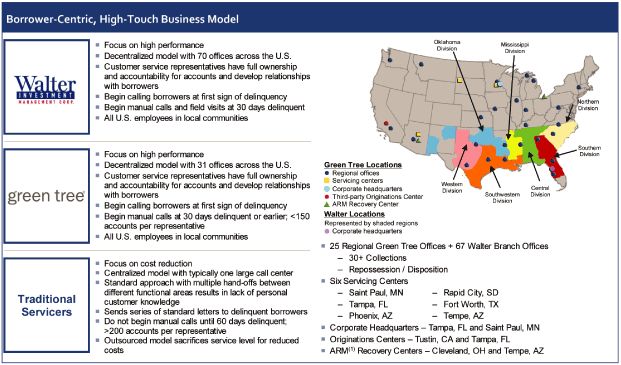
| (1) | Asset Receivables Management. |
The combined company will be a leading third-party specialized servicer for credit sensitive
consumer loans in diverse asset classes, including residential mortgages, manufactured housing and
consumer installment loans. The Company will have a unique decentralized platform operating through
92 combined offices nationwide, in contrast with traditional servicers who typically operate
through a centralized call center.
Walter and Green Tree’s borrower-centric approach succeeds by working with borrowers over the life
of the loan to keep loans current and paying cash, unlike traditional mortgage servicers’ less
intensive approach to loss mitigation. The company achieves this by developing close relationships
with its customers via its customer service and collections representatives. These employees are
given complete authority to work with borrowers, identify solutions and own the performance on the
account for the life of the loan. Our employees are asked to make contact sooner in the
delinquency process and handle fewer accounts than the traditional servicers.

|
Page 17 of 90 |
Both Walter and Green Tree’s servicing portfolio performance has been consistently better than that
of comparable loan pools in the industry. This performance directly leads to material savings for
customers and drives repeat business. As the table below shows, Walter’s portfolio has
outperformed comparable industry pools by more than 40% from a default rate perspective.

| Source: | Mortgage Bankers Association. |
|
| (1) | Delinquencies are derived from a voluntary survey by the Mortgage Bankers Association (MBA)
of over 120 mortgage lenders, including mortgage banks, commercial banks, thrifts, savings and
loan associations, subservicers, and life insurance companies. Delinquency rate is derived by
combining the MBA delinquency rate for subprime loans plus subprime foreclosure starts. MBA
delinquency rate considers all accounts in bankruptcy to be delinquent. Results for March 31,
2011 have not yet been released by the MBA. |
|
| (2) | Walter (industry) calculation considers all accounts in bankruptcy to be delinquent. Walter
(internal) calculation ages accounts in bankruptcy based upon payment status in accordance
with their bankruptcy plan. |

|
Page 18 of 90 |
Similarly, Green Tree’s servicing strategies have had a significant positive impact on default
rates. The chart below reflects a $1.8 billion 2nd lien pool boarded in November 2008. The client
retained a portion of the pool at its previous servicer for comparison purposes (the “Client Loan
Holdout Pool”). Each percentage point of improvement results in approximately $33 million of
savings to the customer, with lifetime to date savings of $106 million and projected lifetime
savings of $128 million. The dollar savings are material and have driven Green Tree to receive
repeat business from existing clients.
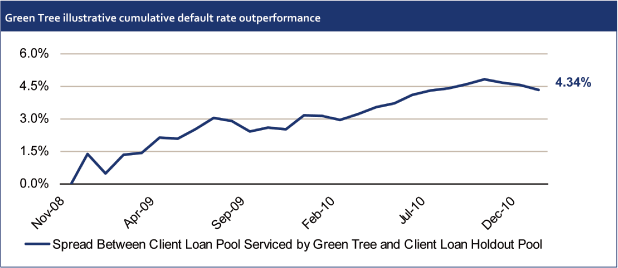
This strong performance allows Green Tree to convert clients and price in incentive fee structures
into its servicing agreements. In 2010, Green Tree earned approximately $20 million in incentive
fees alone.
C. Longstanding relationships with diversified, blue chip customer base
As the industry continues to migrate towards high touch special servicing for credit sensitive
assets, Walter and Green Tree’s strong servicing performance has led to repeat flow business from
credit risk owners. Of the $30.6 billion in new servicing that Green Tree has added to its
platform since 2008, more than 75% has been from recurring clients:
| • | Longstanding relationships with diverse, blue chip customer base generating repeat business |
| • | Strategic client partnerships with GSEs, money center national and regional banks, hedge
funds, major monolines and over 200 securitization trusts |
| • | High brand recognition and strong reputation |
|
| • | Proven ability to outperform traditional servicers |
|
| • | Established IT compatibility and compliance protocols with existing clients represent a barrier to entry |

|
Page 19 of 90 |
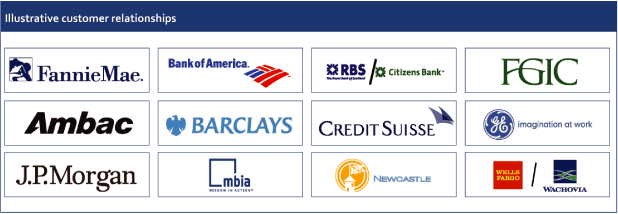
D. Fundamental industry shift toward credit-focused servicers
Walter and Green Tree are uniquely positioned to continue to benefit from a demand-driven
secular shift away from traditional mortgage payment processors towards credit-focused, high-touch
servicers.
Due to increased delinquencies and foreclosures during the cyclical downturn in housing, GSEs,
large banks, securitization trusts, and monoline insurers are experiencing increased volume of
non-performing loans and complexity of servicing, exceeding the in-house capacity or capabilities
of traditional servicers. These traditional servicers have been unable to effectively service
increased numbers of at risk and delinquent loans, reinforcing the need to service credit sensitive
1st and 2nd lien mortgage assets with high-touch strategies offered by third-party specialized
servicers.
Lessons learned in the housing downturn are leading to a secular shift in the market as credit risk
owners and other key constituents (regulators, rating agencies) demand permanent specialized
servicing strategies for higher risk loans.
As the chart below shows, delinquency levels experienced rapid growth from 2006-2009, exposing the
need for special servicers in the mortgage market. The volume of credit-sensitive assets demanding
special servicing attention will remain at elevated levels for an extended period of time and will
be augmented by the origination of credit sensitive assets as the economy improves.

|
Page 20 of 90 |
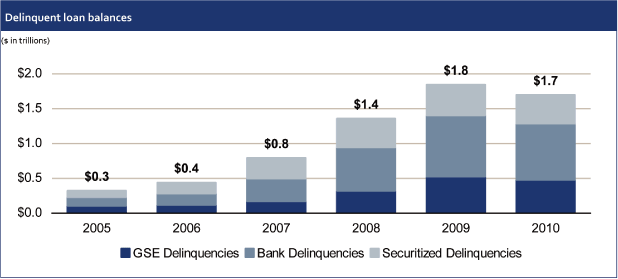
Source: Wall Street Research.
As the following chart shows, a significant portion of performing loans are expected to become
delinquent in coming years, requiring special servicing. Management estimates that $250 billion
of servicing was moved to special servicers in 2010, with similar expectations for 2011.
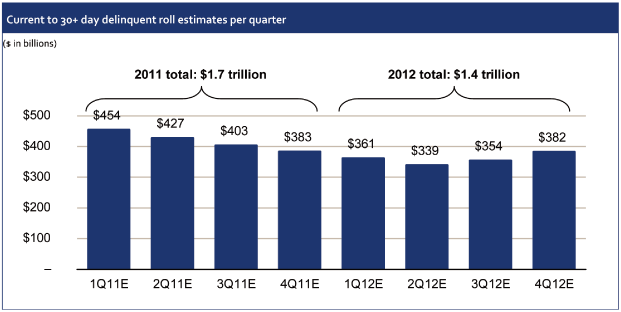
Source: Wall Street Research.

|
Page 21 of 90 |
E. Strong and experienced management team
Post-transaction, the highly experienced management teams of both Walter and Green Tree will
remain with the Company. Walter management will be responsible for public company functions, the
Walter portfolios, strategy, corporate development, and assistance to and oversight of Green Tree.
Green Tree’s management will remain with the Company and continue to run Green Tree’s operations.
Both teams have experience navigating through multiple credit and housing market cycles and have
overseen significant transitions at their respective companies in recent years.
Highly experienced management team |
Mark O’Brien
|
• | Chairman and Chief Executive Officer of Walter Investment Management Corp. |
||
Chairman & CEO
|
• | 21 years in senior roles at Pulte Homes, culminating as President and Chief Executive Officer |
||
| • | Director of Mueller Water Products, Inc. and A. Duda & Sons, Inc. | |||
Brian Libman Chief Strategic Officer |
• | 21 year veteran of the mortgage industry, Mr. Libman has held senior positions in various capacities |
||
• Previously CEO of Green Tree |
||||
• Prior to joining Green Tree, served as CEO of Finance America |
||||
Charles Cauthen President & COO |
• | Variety of financial, operational and executive roles within Walter Industries since 2000 |
||
• Previously CFO of Walter Homebuilding and Financing business |
||||
| • | Prior to Walter, Mr. Cauthen held positions at Bank of America, Barnett Banks, and Deloitte & Touche |
|||
Denmar Dixon
|
• | Private investor and founder and managing partner of Blue Flame Capital |
||
Vice Chairman & EVP
|
• | Retired in 2008 after 23 years with Bank of America | ||
Kimberly Perez CFO |
• | Variety of financial services industry experience including mortgage and homebuilding |
||
| • | Variety of financial and executive roles of increasing responsibility within Walter Industries since 1997 |
|||
| • | Previously served as Audit Manager for PricewaterhouseCoopers | |||
Keith Anderson
|
• | 25 year career in financial services |
||
President & CEO, Green Tree |
• | Variety of financial and executive roles since joining Green Tree in 1995, including Chief Operating Officer, Chief Financial Officer, Treasurer, Chief Accounting Officer and President of the Commercial Finance Group | ||
Cheryl Collins CFO, Green Tree |
• | Variety of financial and executive roles of increasing responsibility within Green Tree since 1990 |
||
| • | Previously served as an Audit Manager at KPMG |

|
Page 22 of 90 |
E. Long-dated and predictable cash flows
Green Tree has added significant recurring revenue each year since 2008. Each new portfolio
provides a predictable cash flow stream for several years to come. Over 70% of 2010 revenue
relates to servicing boarded in 2008 and prior. $5.9 billion of new servicing volume has been added
year to date through 3/31/11. Green Tree has a strong and growing pipeline from existing and new
clients and is expected to continue to build momentum.
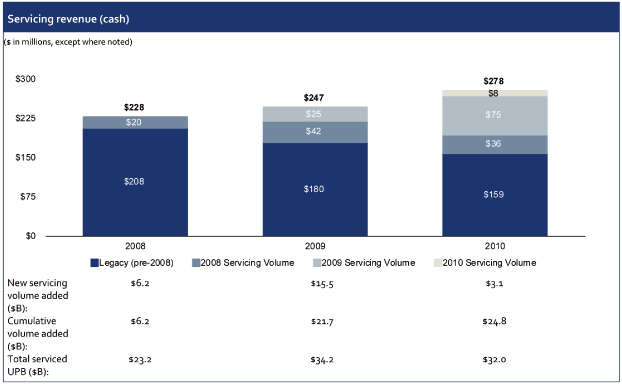
Walter’s portfolio of mortgage loans continues to perform extremely well, generating stable cash
flows benefiting from the performance produced by its field servicing approach, which has delivered
low default rates and high and stable recovery rates on defaulted loans over an extended time
period including the recent downturn. Walter’s portfolio consists almost entirely of high coupon,
fixed rate mortgages match funded with low-cost, non-recourse borrowings, generating a net interest
margin of 5.12% in 2010. Walter’s portfolio is extremely seasoned, with a weighted average
seasoning of 85.6 months and a low and predictable disappearance rate — 7.8% in 2009 and 6.4% in
2010.

|
Page 23 of 90 |
Low working capital and low capex requirements result in a high portion of operating cash flow
being converted into free cash flow.
($ in millions)
| LTM 3/31/11 | ||||||||||||||||
| Green Tree | Walter | Adjustments | Combined | |||||||||||||
Adjusted EBITDA |
$ | 174.7 | $ | 46.9 | $ | 12.0 | $ | 233.6 | ||||||||
Accrual adjustments |
(2.9 | ) | 0.5 | — | (2.4 | ) | ||||||||||
Capex |
(8.5 | ) | — | — | (8.5 | ) | ||||||||||
MSR debt payments |
(10.5 | ) | — | — | (10.5 | ) | ||||||||||
Working capital and investments (1) |
(10.1 | ) | — | — | (10.1 | ) | ||||||||||
Free cash flow before taxes |
$ | 142.7 | $ | 47.4 | $ | 12.0 | $ | 202.1 | ||||||||
Interest expense on corporate debt |
(60.9 | ) | ||||||||||||||
Interest and principal on 2010-1 securitization |
(23.1 | ) | ||||||||||||||
Cash taxes |
(36.8 | ) | ||||||||||||||
Dividends |
(1.1 | ) | ||||||||||||||
Free cash flow |
$ | 80.2 | ||||||||||||||
| Note: | Does not include estimated one-time cost to implement synergies of $15 million. |
|
| (1) | Includes net advances, FHLMC repurchases and net investment in SerVertis. |

|
Page 24 of 90 |
4. Industry overview

|
Page 25 of 90 |
4. Industry overview
A. Mortgage servicing overview
Mortgage servicers operate between credit owners and borrowers and are hired by credit owners or
residential mortgage-backed securities (“RMBS”) trustees to:
| • | Collect and transfer mortgage principal and interest payments to
the owner of the loans and ensure property taxes and insurance
payments are paid and insurance policies are in force |
|
| • | Mitigate losses through loan modifications, short sales and other
options, and manage the foreclosure and REO sale process |
|
| • | Provide other services, including customer service, cash
management, documentation custody, and investor reporting |
A servicer receives a contractually committed servicing fee based primarily on portfolio UPB, type
and quality of asset serviced, ancillary servicer income such as late fees and NSF fees, and may in
some cases receive incentive fees based on performance of the underlying portfolio.
Servicers operate under explicit agreements with loan owners called Pooling and Servicing
Agreements (“PSAs”) in the case of securitizations or Servicing Agreements for whole loan
investors.
The following schematic illustrates the role of a mortgage servicer:
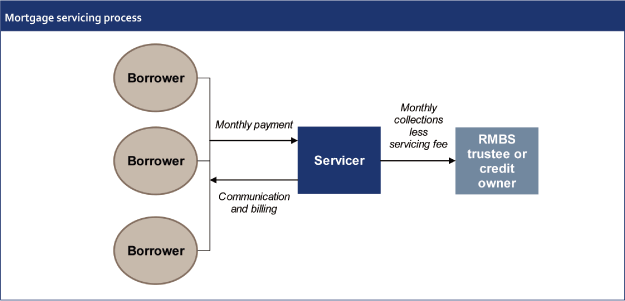

|
Page 26 of 90 |
Walter / Green Tree expertise
Walter and Green Tree are a good fit as both distinguish themselves from traditional mortgage
servicing competitors.
Borrower-centric, high-touch business model
| Traditional servicers | Walter / Green Tree | |||||||
Strategy
|
• | Traditional servicer model was
constructed to process payments for
performing loans and minimize costs |
• | The Company focuses on high-touch
servicing of loans that require significant
loss mitigation and collections expertise |
||||
| • | Commoditized business driven by scale |
• | Provide a differentiated, value-added service — performance driven |
|||||
| • | One size fits all approach | • | Processes are adaptable to meet the needs of portfolios | |||||
Business model
|
• | Centralized model with typically one large call center |
• | Decentralized model with 92 offices
across the U.S. |
||||
| • | Standard approach with multiple hand-offs between different functional areas results in lack of personal customer knowledge | • | Customer service representatives have
full ownership and accountability for accounts
and develop relationships with borrowers |
|||||
| • | Outsourced model sacrifices service level for reduced costs |
• | All U.S. employees in local communities |
|||||
| • | Understaffed for higher levels of
delinquency and foreclosures |
• | Staffed for credit sensitive portfolios | |||||
Collections process
|
• | Send series of standard letters to
delinquent borrowers |
• | Begin calling borrowers at first sign
of delinquency |
||||
| • | Do not begin manual calls until 60 days delinquent; >200 accounts per representative | • | Begin manual calls at 15-30 days delinquent; 120-130 accounts per representative | |||||
Revenue model
|
• | Typically flat servicing fee of 25
bps regardless of loan status • Not compensated for taking on more
labor-intensive portfolios or for better
performance
|
• | Innovative incentive fee arrangements
with clients (optimal risk-return profile for
the servicer and the client) • Performing successful loss mitigation or
repayment arrangements as well as performing
REO sales, short sales or other liquidation
activities |
||||
• Arrangements are typically based on either a
flat $ amount per transaction or a % of the
cash collected from the activity |
||||||||
| • | Total servicing revenues of 80-85 bps for Green Tree and 60 bps for Walter | |||||||

|
Page 27 of 90 |
Mortgage loan lifecycle
The mortgage lifecycle begins at loan origination with lead and sales management, loan processing,
loan underwriting and loan closing, performed typically by the originating institution. Once a loan
is originated, a mortgage servicer (captive or third-party servicer) then boards the loan (borrower
and property information, mortgage terms, etc.) into its systems and commences billing and
collecting monthly payments (principal, interest and escrow payments such as taxes and insurance)
from borrowers and remits to investors. This entails multiple sub-processes such as quality
control, customer service, cash management and escrow management. For sub-performing loans, the
servicer also manages delinquency procedures and default management, which may include loan
modification, short sales, or other loss mitigation tools, in addition to foreclosure and REO sales
for investors. The mortgage loan lifecycle ends with the investor releasing the lien on the
property when (a) the borrower has fully paid the loan through refinancing, sale of property, or
made all scheduled payments or (b) for non-performing loans, the home underlying a delinquent loan
is foreclosed and sold by the servicer with proceeds of the sale used to satisfy the loan.
The following schematic illustrates the mortgage loan lifecycle and summarizes the key revenue and
expense drivers for a mortgage servicer:


|
Page 28 of 90 |
Types of servicing contracts
Third-party mortgage servicers obtain new servicing portfolios through two different channels:
Servicing acquisition channels
Sub-servicing agreements
| • | Enter into a contract with a
third-party to provide servicing;
third-party retains primary ownership of
the underlying servicing |
|
| • | No upfront payment required |
|
| • | Does not create a balance sheet
asset |
|
| • | Typically long-term (multi-year or
life of loan) contracts with ability to
terminate for a fee |
|
| • | Typically have very limited
servicer advance obligations (servicer
advance obligations retained by the
investor or primary servicer) |
Purchased mortgage servicing rights (“MSRs”)
| • | MSR is recorded when a servicer purchases the rights to service a pool
of loans through an upfront payment |
|
| • | MSR asset represents the net present value of expected servicing
revenue net of servicing costs for the pool |
|
| • | Ownership is generally noncancelable with low risk of transfer |
|
| • | Typically creates a servicer advance obligation, although this can be
negotiated with the seller |

|
Page 29 of 90 |
B. Competitive trends
Regulatory and structural shifts in the sector are driving business to specialty servicers. The
combined company is well positioned to capitalize on sector trends.
| During the Downturn | Today | The Future | ||||
Sector trends
|
• Aggressive
origination and lending
standards contributed to
economic downturn
• Delinquencies,
foreclosures and losses
grew tremendously
• Traditional
servicers couldn’t handle
increased volume of
problem assets
• Credit risk owners
suffered significant
losses
|
• High level
of
credit-challenged
assets persist
• Structural
changes in
servicing industry
underway
• Shift
toward specialized
servicers
• Credit risk
owners recognize
the value of
specialized, credit
focused servicers
|
• High levels of
credit sensitive assets in
the mortgage market
expected to continue
• Regulatory
environment for servicing
will continue to evolve
• Basel III • AG settlement on
servicing protocols • Servicing compensation • The ability to flow
assets to special servicers
expected to become easier
and the volume of transfers
expected to accelerate |
|||
 |
 |
 |
||||
Walter /Green
Tree
|
• Evolved
manufactured housing loss
mitigation strategies to
first and second lien
residential market
• Increased
investment in technology
• Focused on
high-touch collections and
loss mitigation processes
• Developed
complementary businesses
• Investment
management • Asset receivables
management (“ARM”) |
• Building
upon relationships
with existing blue
chip credit risk
owners
• Differentiating
performance against
other servicers
• Customizing
servicing protocols
to meet client
specific needs
• Robust
pipeline of
prospective
business from
existing and new
clients
|
• Continue to drive
growth from blue chip
credit risk owners
• Expand capacity
across platform
• Develop
capabilities in other high
risk mortgage products
• FHA • Delinquency flow servicing • Field Services • Component servicing • Continue to enhance
compliance and control
environment |
Competitive Landscape
There are many players in the mortgage servicing industry employing a variety of very different
business models. The competitive landscape can be grouped into the following categories:
| • | Prime servicers within the largest U.S. banks that service primarily performing mortgages with a low-cost
processing-oriented strategy |
| • | Captive servicers affiliated with originators or investors that service their own portfolio |
|
| • | Independent servicers that service portfolios for third-parties either through sub-servicing agreements or by MSR
purchases |

|
Page 30 of 90 |
Varying types of servicers
| Prime Servicers | Captive Servicers | Independent | ||
| (Large National Banks) | (Affiliates of Investment Banks) | Specialized Servicers | ||
Service $100+ billion UPB of prime,
performing mortgage originated by the
largest U.S. banks
|
Servicers for largest investment banks’ securitizations and on-balance sheet assets | Typically service for third-parties on a fee- for-service basis |
||
• Bank of America
|
• Aurora (Lehman)
|
• Green Tree |
||
• Wells Fargo
|
• Litton (Goldman Sachs)
|
• American Home |
||
• JPMorgan Chase
|
• SPS (Credit Suisse)
|
• Ocwen |
||
• Citi
|
• Saxon (Morgan Stanley)
|
• Nationstar |
||
• Ally Financial
|
• Wilshire (IBM) |
|||
• US Bank Home Mortgage
|
• Carrington |
|||
Not direct competitors; however, in many
cases, these servicers may contract with
Green Tree as a sub-servicers for
certain troubled portfolios
|
Among the Independent Servicers, Green Tree is differentiated by its decentralized structure, specialized approach, collection-focused servicing protocol, very low level of advances and higher margins |
C. Sizing the market
Loan servicing market opportunity
The U.S. residential mortgage market has approximately $10.5 trillion in loans outstanding. The
large underlying market of mortgage assets requiring specialized servicing and collection presents
an addressable opportunity for Walter and Green Tree.
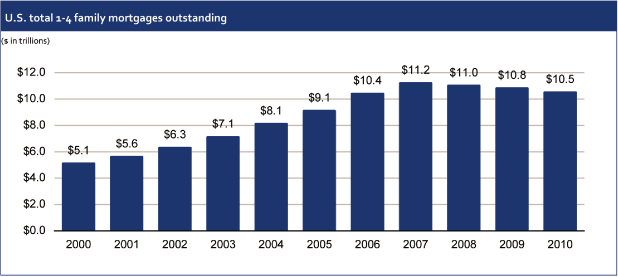
| Source: | Inside Mortgage Finance. |

|
Page 31 of 90 |
Due to increased delinquencies and foreclosures during the cyclical downturn in housing, credit
owners are experiencing increased delinquencies and complexity of servicing, exceeding the in-house
capacity or capabilities of traditional servicers. Credit owners include GSEs, large banks,
securitization trusts, and monoline insurers.
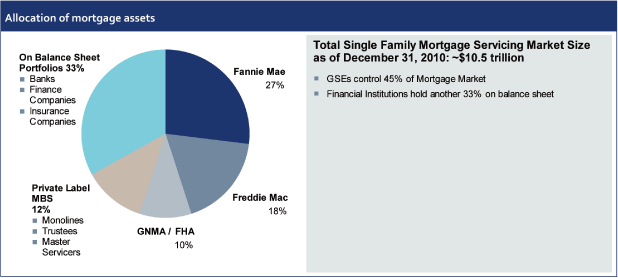
| Source: | Inside Mortgage Finance. |
During the housing downturn, a cyclical opportunity arose as several vintages, geographies and
mortgage classes experienced higher than expected delinquency and foreclosure rates. These
categories include the 2005-2007 vintages, as well as limited documentation, low FICO score and
high combined loan-to-value (“CLTV”) loans, subprime loans, Alt-A loans, home equity lines of
credit (“HELOCs”), and other higher-risk GSE/FHA/VA conforming loans.
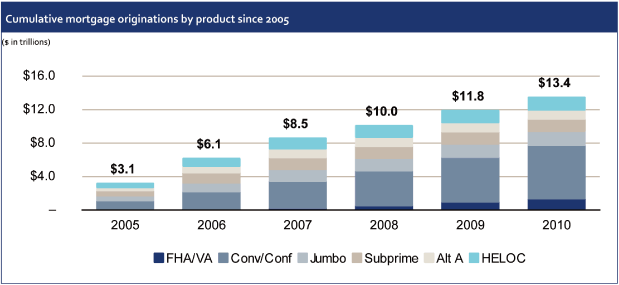
| Source: | Inside Mortgage Finance. |

|
Page 32 of 90 |
Major banks are currently experiencing delinquencies of up to 9% of their holdings and GSEs 4% of
their holdings.
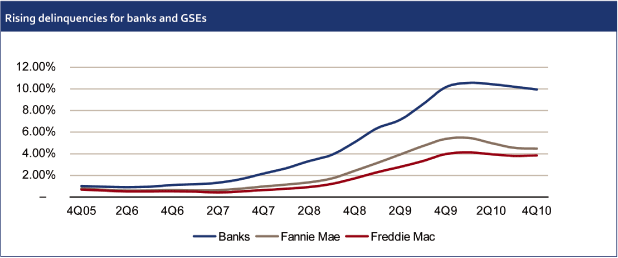
| Source: | Federal Deposit Insurance Corporation, Fannie Mae, Freddie Mac. |
|
| Note: | Banks reflect 90+ delinquencies and nonaccrual loans on closed-end
first lien 1-4 family residential mortgages. Fannie Mae and
Freddie Mac reflect 90+ delinquencies on loans in foreclosure on
single-family loans. |
Additionally, during the crisis a large quantity of mortgage loans in the market have been modified
to remain current. Roughly 60% of these loans are expected to re-default, placing further pressure
on mortgage credit owners. This represents an additional opportunity for specialized credit
servicers.
Green Tree’s market opportunity stems from three major components:
| • | $1.7 trillion of existing delinquent mortgage assets |
|
| • | Current performing mortgage loans yet to become delinquent |
|
| • | Newly originated loans expected to require specialized servicing |
Troubled assets, or mortgages in delinquency or foreclosure, increased from $0.3 trillion to $1.8
trillion from 2005-2009. These troubled assets remain elevated at $1.7 trillion at the end of 2010.
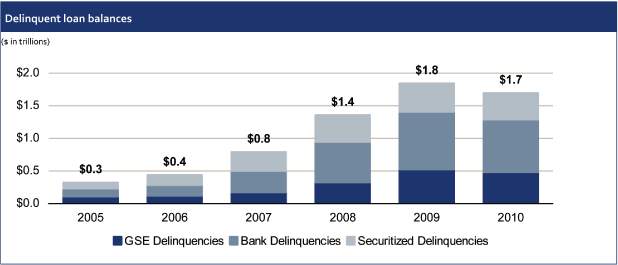
| Source: | Wall Street Research. |

|
Page 33 of 90 |
Additionally, out of the $9.2 trillion in performing loans outstanding, approximately $3.1 trillion
is expected to become 30+ days delinquent in 2011 and 2012.
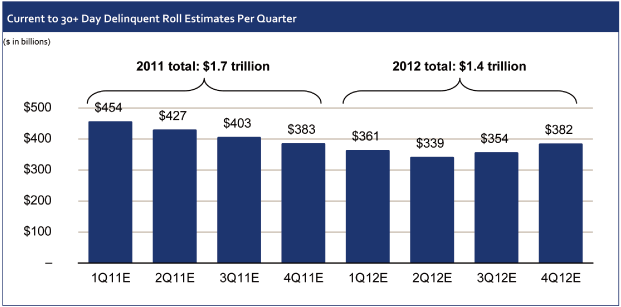
| Source: | Wall Street Research. |
In addition to existing loans outstanding, originations of new high risk loans are expected to be
over $300 billion annually, and coming out of the current housing crisis, management expects a high
level of homeowners will have been seriously delinquent, received a loan modification, or been
through a foreclosure. All of these homeowners will be considered high-risk and will likely
require specialized servicing.
Sources of new high risk loan originations include the following:
| • | Under current credit parameters, 10% of conventional mortgage originations will be higher risk
(FICO score < 660, LTV > 90%, or investor-owned properties) |
|
| • | 70% of the $350 billion of annual FHA-insured loans originated will be high risk (LTV > 90%) |

|
Page 34 of 90 |
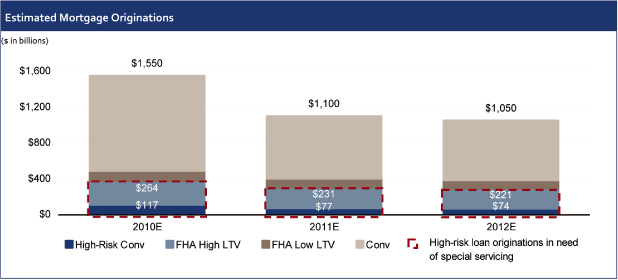
| Source: | Freddie Mac Estimate of Conventional 1 — 4 Family Mortgage Originations as of 4/13/11. |
Green Tree and Walter excel at servicing delinquent loans and improving performance through
collections and loss mitigation. Today, there is an enormous market potential in delinquent loans
and the elevated levels of loans becoming delinquent in the next several years.
In addition to the cyclical opportunity outlined above, lessons learned in the housing downturn are
leading to a secular shift in the market as credit risk owners and other key constituents
(regulators, rating agencies) demand permanent specialized servicing strategies for higher risk
loans.
Traditional servicers, utilizing standard automated payment processing techniques, have been unable
to effectively service increased balances of delinquent loans, leading to elevated losses for
mortgage credit owners. This has reinforced to credit risk owners the need to service troubled 1st
and 2nd lien mortgage assets with high-touch strategies offered by third-party specialized
servicers and collectors.
In addition to its primary focus as a mortgage servicer, Green Tree is highly skilled at servicing
multiple asset classes and has opportunistically serviced different asset classes in various market
cycles.

|
Page 35 of 90 |
5. Walter overview

|
Page 36 of 90 |
5. Walter overview
Walter Investment Management Corp., together with its consolidated subsidiaries, is an asset
manager, mortgage portfolio owner and mortgage servicer specializing in less-than-prime,
non-conforming and other credit-challenged mortgage assets primarily in the southeastern United
States.
Walter was established in 1958 as the financing arm of Walter Energy; the financing business
originated and purchased residential loans for customers of Jim Walter Homes (“JWH”), an
on-your-lot homebuilder, and serviced these residential loans to maturity. In April 2009, Walter
was spun out from Walter Energy and became a publicly traded Real Estate Investment Trust (“REIT”)
through a reverse merger with Hanover Capital (“Hanover”). Walter is listed on the NYSE Amex under
the ticker WAC.
In 2010, Walter began acquiring pools of residential loans from third parties. As of March 31,
2011, Walter had residential loans of $1.8 billion. Residential loans are held for investment and
consist primarily of residential loans held in securitization trusts, as well as a limited amount
of unencumbered residential loans. Historically, Walter has funded its residential mortgage loans
through non-recourse securitizations that are consolidated on its balance sheet for accounting
purposes. The company’s only continued involvement with the residential loans held in
securitization trusts is retaining all of the beneficial interests in the securitization trusts and
servicing the residential loans collateralizing the mortgage-backed debt.
As of March 31, 2011, Walter had eleven separate non-recourse securitizations outstanding, with an
aggregate of $1.3 billion of outstanding debt, which fund residential loans and REO with a
principal balance of $1.7 billion. All of the company’s debt is non-recourse and not
cross-collateralized and, therefore, must be satisfied exclusively from the proceeds of the
residential loans and REO held in each securitization trust.
In November 2010, Walter acquired Marix, a “high-touch” specialty mortgage servicer. Based in
Phoenix, Arizona, Marix is focused on default management, borrower outreach, loss mitigation,
liquidation strategies and component and specialty servicing.
Through the years, the Company has developed a highly effective loan sourcing and transaction
process, operating in conjunction with a high-touch relationship based servicing platform with
field servicing representatives in 70 offices across 14 states. Going forward, Walter will
discontinue its portfolio acquisition program and its portfolio of residential loans will run off
over time. The combined company will focus its efforts on Green Tree’s asset-light, fee-based
servicing opportunities, where it believes the risk-reward proposition is most attractive. While
Walter has been a very successful owner and servicer of credit sensitive assets, the Green Tree
opportunity offers comparable returns and superior growth prospects without the associated credit
risk.
A. Drivers of profitability
Walter’s objective is to earn attractive risk-adjusted returns for its stockholders. Walter
seeks to achieve this objective through maximizing income resulting from the spread between the
interest income the company earns on its existing residential loan portfolio and the interest
expense it pays on its borrowings, or its net interest income. Walter believes the acquisition of
Marix will help the company achieve these long-term goals by allowing the company to more
effectively pursue fee based servicing opportunities for mortgages owned by others. In addition to
originating, purchasing and servicing residential loans, Walter also provides property insurance
for homeowners.

|
Page 37 of 90 |
Walter drivers of profitability
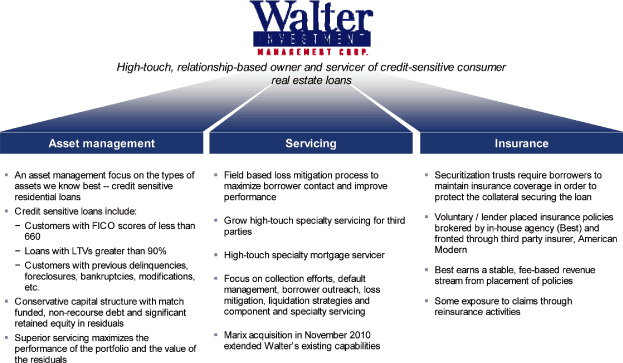
B. Asset management
Walter’s portfolio of mortgage loans continues to perform extremely well, generating stable
cash flows benefiting from the performance produced by its field servicing approach, which has
delivered low default rates and high and stable recovery rates on defaulted loans over an extended
time period including the recent downturn. Walter’s portfolio consists almost entirely of high
coupon, fixed rate mortgages match funded with low-cost, non-recourse borrowings generating a net
interest margin of 5.12% in 2010. Walter’s portfolio is extremely seasoned, with a weighted
average seasoning of 85.6 months and a low and predictable disappearance rate — 7.8% in 2009 and
6.4% in 2010.
As shown below, Walter has experienced default rates and recovery rates in a relatively narrow
band, even during the recent downturn. Walter has utilized its field servicing platform very
effectively to improve the performance of acquired pools over that time frame.

|
Page 38 of 90 |
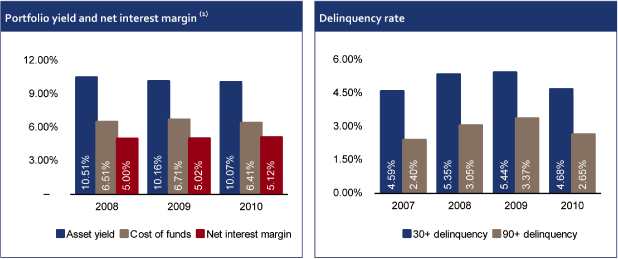
| (1) | In order to provide comparability between periods presented, certain amounts have been
reclassified from the previously reported results to conform to the current presentation. |
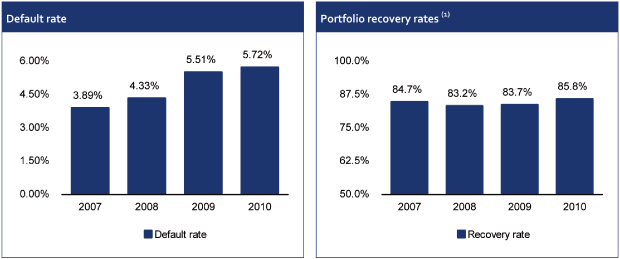
| (1) | Represents recovery rates on REO sales. |
The characteristics of Walter’s owned portfolio have contributed to their strong performance
and cash flow. 98% of Walter’s residential loans are comprised of fixed rate mortgages secured by
owner-occupied, single-family homes. As illustrated by its geographic concentration, Walter’s
portfolio is made up of seasoned residential loans located outside major markets less affected by
home price volatility.

|
Page 39 of 90 |
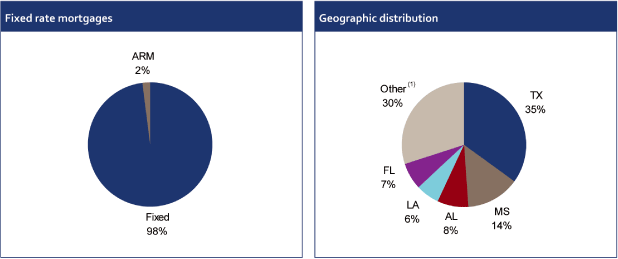
| (1) | Other consists of loans in 40 states, individually representing a concentration of less
than 5%. |
95% of Walter’s portfolio is current, with only 3% 90+ days delinquent. Walter’s residential
loan portfolio is also well-seasoned with 48% of loans originated in 2004 and earlier.
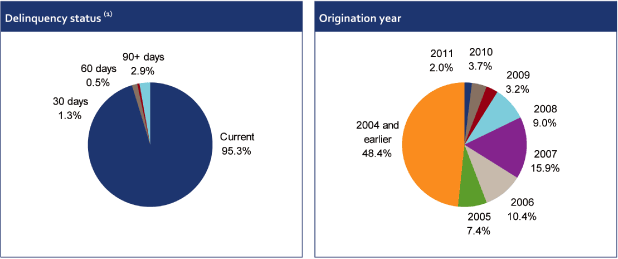
| (1) | Accounts in bankruptcy paying in accordance with their plan are considered current.
Delinquency status as of March 31, 2011. Expressed as a percentage of principal balance of
residential loans outstanding as of March 31, 2011. |
Walter’s debt is match funded with no refinancing or liquidity risk. 95% of the company’s debt
is rated investment grade by S&P and 77% by Moody’s.

|
Page 40 of 90 |
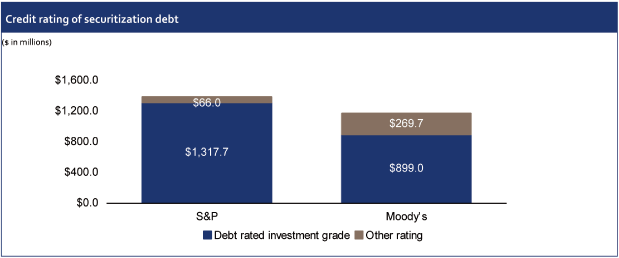
|
||
Note: Moody’s data includes only bonds that have been rated by Moody’s.
C. Loan servicing
Walter Investment has developed and retained a force of 125 highly experienced field servicing
professionals with a deeply ingrained understanding of the customer base and experience through
previous housing cycles.
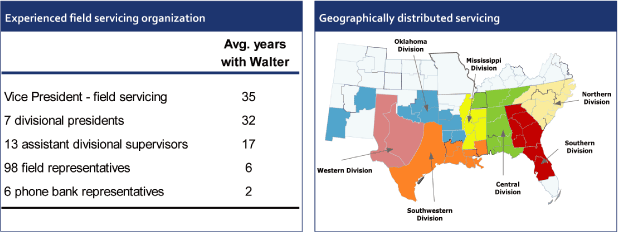
Walter’s strong servicing relationships and regular interaction with borrowers allow for strong
portfolio performance and low loss rates. Walter employs a customized approach to delinquency
management:
| • | High-touch, long-term relationship based approach primarily aimed at keeping customers in their homes |
|
| • | Field servicing representatives develop extensive knowledge of individual customers’ financial situations and local
real estate markets |
|
| • | Local field-servicing representatives are involved in virtually all aspects of the servicing and loss mitigation
functions |
|
| • | Field-servicing representatives focus on accounts that will be 30+ days delinquent at month end if not collected |
|
| • | Strong sense of ownership/accountability for accounts by servicing personnel |
|
| • | Call center is a support function, allowing field representatives to perform more “on-the-ground” functions |

|
Page 41 of 90 |
Illustrative servicing contact rate
Number of accounts |
33,000 | |||||||
Number of accounts with contact attempts |
13,000 | or | 40% of all accounts | |||||
Number of contact attempts |
70,000 | or | 5.4 attempts per account | |||||
Number of accounts visited at their home |
2,800 | or | 9% of all accounts | |||||
Number of home visits |
4,800 | or | 1.7 visits per account | |||||
Accounts successfully resolved at month end |
12,400 | or | 95% success rate | |||||
Number of delinquent accounts at month end (ex. BK, FIP) |
600 | or | 1.8% of all accounts | |||||
Delinquent accounts without a successful contact attempt |
50 | or | 0.14% of all accounts |
Walter’s portfolio performance has been significantly better than that of the subprime
mortgage market, with default rates which have been consistently lower than industry averages.
Walter’s effective high-touch servicing has translated into reduced losses and increased
profitability for Walter and third-party clients.
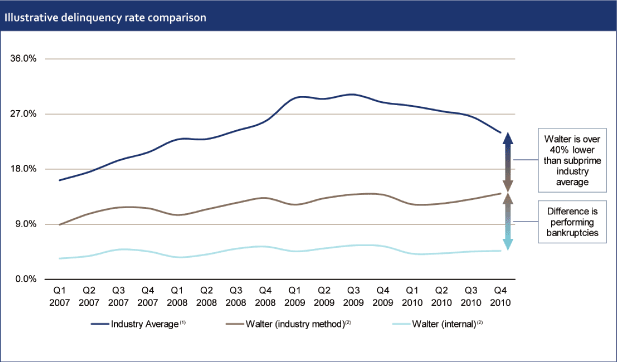
Source: Mortgage Bankers Association.
| (1) | Delinquencies are derived from a voluntary survey by the Mortgage Bankers Association (MBA)
of over 120 mortgage lenders, including mortgage banks, commercial banks, thrifts, savings and
loan associations, subservicers, and life insurance companies. Delinquency rate is derived by
combining the MBA delinquency rate for subprime loans plus subprime foreclosure starts. MBA
delinquency rate considers all accounts in bankruptcy to be delinquent. Results for March 31,
2011 have not yet been released by the MBA. |
|
| (2) | Walter (industry) calculation considers all accounts in bankruptcy to be delinquent. Walter
(internal) calculation ages accounts in bankruptcy based upon payment status in accordance
with their bankruptcy plan. |

|
Page 42 of 90 |
6. Green Tree overview

|
Page 43 of 90 |
6. Green Tree overview
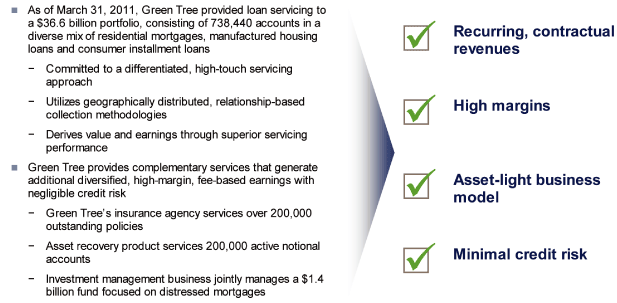
A. Green Tree history
Over a 30-year period, Green Tree has evolved from an originator and servicer of MH,
residential and consumer loans to a diversified solutions provider to owners of credit-sensitive
assets.
Green Tree has over 30 years of experience servicing credit-sensitive consumer loans and
depreciating assets. Founded in 1975, Green Tree Financial Corporation was later acquired by
Conseco Inc. in June 1998. Green Tree Financial Corporation was focused on originating and
servicing MH loans, consumer loans and 1st and 2nd lien residential mortgages.
Following Conseco’s bankruptcy in December 2002, an investor group led by Fortress Investment Group
and Cerberus Capital Management purchased certain assets of the former Green Tree Financial
Corporation. The buyers were able to substantially increase servicing fees and move the fees to be
the most senior of all cash flows. The business model focused on generating cash flows from
leveraging Green Tree’s balance sheet to purchase whole loans and securities and primarily managing
the business as a “run-off” of existing servicing contracts for MH loans.

|
Page 44 of 90 |
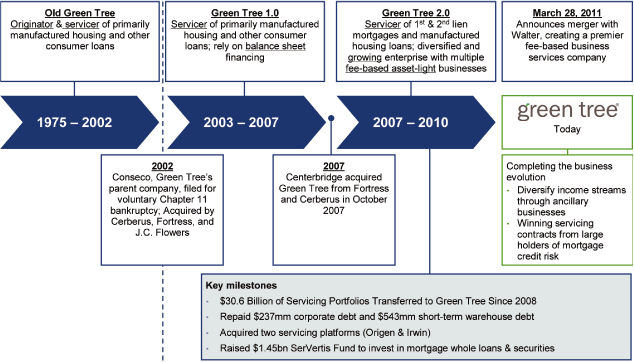
Business Evolution Implemented by Management and Centerbridge
Centerbridge and management acquired Green Tree with an investment thesis that Green Tree’s
core competency in loan servicing and cash collections for MH loans and credit-sensitive home
equity loans would be in increasingly higher demand by third-party owners (e.g., GSEs, large
commercial banks, monoline insurers, hedge funds, regional banks, etc.) of other credit-sensitive
assets. Since the acquisition, Centerbridge and Management have evolved Green Tree’s business via a
strategic plan for growing Green Tree into an asset-light fee-for-service provider to third
parties. As part of this evolution, Green Tree has improved its operational and financial
stability, built new complementary businesses and dramatically reduced recourse leverage.
Business strategy
Centerbridge and Management have succeeded in building a business growth strategy that
executes on the investment thesis of being the leading third-party servicer for clients with
credit-sensitive assets while maximizing revenue per customer by offering complementary fee-based
services.

|
Page 45 of 90 |

Strategic initiatives have included:
| • | Growing Green Tree’s core servicing revenue by concentrating on the credit owner where portfolio performance drives servicing placement decisions |
|
| • | Maintaining consistent Insurance Agency revenue through penetration of new MH and non-MH servicing portfolios |
|
| • | Expanding ARM to capture independent contingency fee contracts with third parties, in addition to the flow from the loan servicing portfolio |
|
| • | Increasing Investment Management assets under management through deployment of the SerVertis Fund and raising follow-on third-party investment funds |
|
| • | Developing fee-for-service Third-Party Originations as a “tack-on” product for existing servicing accounts |
Key growth areas:
| • | Loan servicing |
| • | Build on foundation of servicing excellence |
||
| • | Diversification through expansion into servicing other loan types and asset classes |
||
| • | Added $30.6 billion UPB servicing volume from 2008 through 3/31/11 |
||
| • | Grow ARM product by adding “stand alone” clients and expanding product array |
||
| • | 43% CAGR in notional balance of deficiency portfolio from 2008 to March 2011 |
| • | Insurance agency |
| • | Insurance Agency benefiting from growth in 1st lien mortgages |
||
| • | Average premium per policy for the Insurance Agency has posted a 7% CAGR from 2008 to March 2011 |
| • | Created new business lines |
| • | Investment Management established in 2008; co-manager of $1.4 billion mortgage fund |
||
| • | Fee-based Originations business established in 2009 |
||
| • | Through March 2011, $980 million of capital deployed through 12 whole loan transactions, acquiring $1.9 billion of UPB |
Technology leader with proprietary systems
Green Tree has the requisite servicing protocols, technology, management expertise and financial
resources to partner with clients to manage risk and enhance performance of a broad range of credit
sensitive assets.
Fully integrated enterprise workflow technology seamlessly integrates servicing, collections, legal
tracking and default management activities optimizing employee performance.

|
Page 46 of 90 |

Strong independent controls and monitoring
Independent controls and monitoring are critical to Green Tree’s success and to ensure compliance
with legal and regulatory requirements. Green Tree has in place all the necessary independent
controls and processes to mitigate risk.
In addition to the company’s internal processes, Green Tree is audited by the states regulators it
does business in and clients perform continued operational reviews.

|
Page 47 of 90 |

| B. | Business development |
The Business Development team at Green Tree is primarily responsible for sourcing new
relationships. They work with senior management to leverage their deep industry relationships with
GSEs and major financial institutions to gain new business and explore opportunities to expand
existing relationships. Green Tree obtains new servicing portfolios from:
| • | New servicing customers: Commercial banks, investment banks,
monoline insurers, and securitization trustees are actively
seeking to place portfolios with new specialized servicers as
traditional processing-oriented mortgage servicers remain
overwhelmed by the volume of defaults and are ill-equipped to
maximize the value of credit-sensitive assets |
|
| • | Existing servicing customers: Green Tree provides services to a
diversified, blue chip customer base that includes GSEs, national
and regional banks, major monolines and over 200 securitization
trusts. Repeat business generation is a focus of Green Tree and
several of its largest customers have provided multiple servicing
portfolios |
|
| • | Opportunistic acquisitions: Green Tree will opportunistically seek
to acquire servicing platforms, such as the Origen and Irwin
acquisitions completed in July 2008 and April 2009, respectively |
|
| • | Investment management business: Acquisitions of loan portfolios by
the Investment Management business through their SerVertis Fund,
for which Green Tree performs all servicing |
|
| • | Secondary markets: Green Tree’s Investment Management business
provides access to secondary market opportunities to acquire MSRs
or sub-servicing contracts |

|
Page 48 of 90 |
Since early 2008, Green Tree has transferred $30.6 billion of servicing portfolios from a diverse
range of customers, contracts and servicing assets including the first MSR transaction sold by the
FDIC and roll-ups from financial institutions re-organizing/exiting the sector (Irwin, Origin,
BankUnited).

Servicing contract diligence process
The following flow chart outlines the standard process and procedures for managing and executing
the acquisition of new servicing. The sourcing and execution of a servicing portfolio is primarily
driven by parameters established to meet Green Tree’s strategic objectives, while ensuring
consistency and detailed assessment of the risks and potential upside. The evaluation and diligence
of a servicing portfolio is a multifunctional task leveraging Green Tree’s expertise across
business units. The following flow chart illustrates the acquisition process.

|
Page 49 of 90 |

Green Tree’s new servicing business profitability
Green Tree’s legacy portfolio primarily consists of securitized manufactured housing loans which
provide a consistent profitable base to build from. Green Tree continues to grow its core
servicing revenue by winning servicing business from new and existing clients and boarding non-MH
servicing portfolios. In March 2011, revenue from new business (boarded 2008 and later) exceeded
revenue from legacy business (boarded pre-2008).
Revenue split
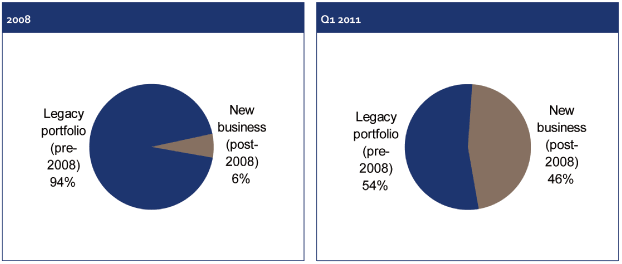

|
Page 50 of 90 |
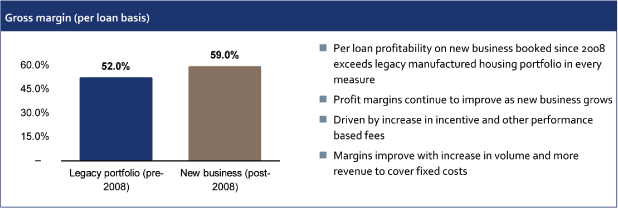
Green Tree has a strong and growing pipeline as demonstrated by the indicative opportunities below:
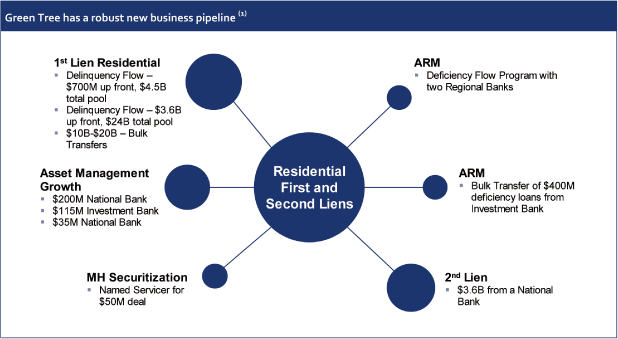
| (1) | New business is subject to completion of contractual commitments and is not guaranteed. |

|
Page 51 of 90 |
| C. | Loan servicing |
As of March 31, 2011, Green Tree serviced a $36.6 billion loan portfolio consisting of
approximately 738,440 loans and is one of the largest independent servicers. Green Tree performs
servicing primarily on behalf of third-parties, including securitization trusts and whole loan
investors. Green Tree is an approved GSE third-party servicer. Green Tree is the largest servicer
of manufactured housing loans in the U.S. Green Tree services a wide range of consumer assets
including traditional 1st lien mortgages, home equity and other consumer installment loans.
Green Tree is licensed or exempt from licensing in the 48 contiguous states and the servicing
platform is rated by Moody’s, S&P and Fitch. It is also one of the few servicers to receive
servicer rating upgrades in the past year.
The loan servicing business is split between two core products:
| • | Third party loan servicing on open / active accounts |
|
| • | Asset receivables management on charge-off / deficiency balances |
Key drivers of earnings growth include:
| • | Adding profitable portfolio growth |
|
| • | Spreading fixed costs over broader base |
|
| • | Earning incremental ancillary/incentive revenues |
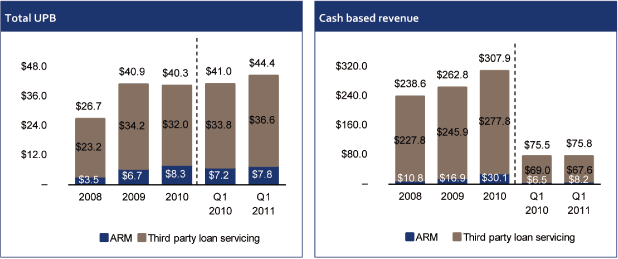
Third-party loan servicing
Product overview
Green Tree’s core product is fee-for-service third party mortgage loan servicing with a focus on
portfolio owners that retain credit risk on their balance sheet. Its current manufactured housing
legacy book provides a stable, profitable base of recurring revenue. Green Tree is a best-in-class
servicer with delinquency rates amongst the lowest in the industry for comparable asset classes.
Green Tree employs a decentralized, “high touch”, borrower-centric servicing model and is an
approved servicer for FNMA, FHLMC and the government’s HAMP program. Green Tree is a highly rated
mortgage servicing platform evaluated by Moody’s, S&P and Fitch.

|
Page 52 of 90 |
Key revenue drivers
Green Tree’s third-party loan servicing produces long-dated, stable, predictable, contractual
fee-based revenues.
Key revenue drivers include:
| • | Servicing fees: Generally based on a percentage of underlying loan UPB and varies by asset class |
| • | Contractual fees are recurring and predictable |
||
| • | Incentive fees earned based on performance of loan pools |
||
| • | Majority are senior in priority and no risk of non-payment |
| • | Other fees: Late fees, NSF fees, loan modification fees, and other ancillary fees |
|
| • | Size of servicing portfolio: Primary driver of segment revenue |
| • | Margins have remained consistent |
||
| • | New business boarded more than offsets portfolio run-off |
||
| • | Green Tree has demonstrated a superior track record over the past three years boarding $31 billion of UPB |

Profitability
Since 2008, Green Tree has boarded $30.6 billion of new servicing portfolios and further
diversified its customer base to include national and regional banks, GSEs, other investors and
over 200 securitization trusts. The following charts show the current diversification of Green
Tree’s servicing portfolio.
Green Tree’s new business added since 2008 is profitable with strong revenues and margins. The
chart below demonstrates that on a per loan basis, the 1st and 2nd lien
product types are more profitable than the core manufactured housing legacy portfolio.

|
Page 53 of 90 |
Profit per loan
| Product type | Revenues | Net income | ||||||
Government 1st lien |
$ | 960 | $ | 553 | ||||
Non-Government 1st lien |
1,139 | 727 | ||||||
Other - 2nd lien |
450 | 205 | ||||||
Manufactured housing |
461 | 206 | ||||||
| Note: | For the three months ended 3/31/11 annualized. |
Green Tree’s diversified portfolio (as of 3/31/11)
| Manufactured Housing | Residential | |||||||||||||||||||||||
| Chattel | Land home | 1st lien | 2nd lien | Other | Total | |||||||||||||||||||
UPB ($bn) |
$ | 9.47 | $ | 3.75 | $ | 13.09 | $ | 10.23 | $ | 0.04 | $ | 36.59 | ||||||||||||
% of Total UPB |
25.9 | % | 10.3 | % | 35.8 | % | 28.0 | % | 0.1 | % | 100.0 | % | ||||||||||||
Count |
352,595 | 68,393 | 86,915 | 226,819 | 3,718 | 738,440 | ||||||||||||||||||
Average balance ($) |
$ | 26,870 | $ | 54,897 | $ | 150,634 | $ | 45,095 | $ | 10,918 | $ | 49,551 | ||||||||||||
Weighted average coupon |
9.58 | % | 8.07 | % | 6.22 | % | 8.49 | % | 10.74 | % | 7.92 | % | ||||||||||||
Weighted average maturity (mo.) |
135 | 187 | 270 | 156 | 55 | 194 | ||||||||||||||||||
Age (mo.) |
143 | 143 | 57 | 54 | 143 | 88 | ||||||||||||||||||
Loan-to-value |
94 | % | 78 | % | 92 | % | 100 | % | 87 | % | 93 | % | ||||||||||||
Current FICO |
644 | 642 | 675 | 704 | 688 | 672 | ||||||||||||||||||
Top five states
TX |
13.7 | % | NC | 14.4 | % | CA | 16.7 | % | CA | 19.8 | % | CA | 16.5 | % | CA | 13.3 | % | ||||||||||||||||||||||||||
GA |
8.2 | % | FL | 9.2 | % | FL | 15.3 | % | FL | 5.0 | % | TX | 13.6 | % | FL | 9.1 | % | ||||||||||||||||||||||||||
NC |
7.8 | % | GA | 6.7 | % | IL | 7.6 | % | VA | 4.9 | % | FL | 9.3 | % | TX | 6.7 | % | ||||||||||||||||||||||||||
AL |
7.6 | % | SC | 5.3 | % | MD | 5.5 | % | TX | 4.3 | % | AZ | 5.1 | % | GA | 4.9 | % | ||||||||||||||||||||||||||
SC |
6.9 | % | TN | 4.5 | % | VA | 5.0 | % | CO | 4.1 | % | WA | 4.2 | % | NC | 4.7 | % | ||||||||||||||||||||||||||

Unique servicing model
Green Tree has a unique decentralized, borrower-centric servicing approach ideally suited to
maximize value and cash collections of credit-sensitive assets. The highly flexible model allows
for maximum customization to meet individual customer requirements, and is further differentiated
through providing personal contact at critical customer touch points.
Green Tree’s servicing strategy is a high-touch, life of loan approach that focuses on life of loan
accountability, early intervention and triage, and loss mitigation. This approach facilitates
strong relationships with borrowers, higher customer satisfaction and greater employee
accountability and ultimately produces superior portfolio performance.

|
Page 54 of 90 |
Adaptable servicing processes
1
|
Life of loan accountability | • Collectors remain permanently assigned to 30+ delinquent borrowers to ensure relationship
continuity and accountability |
||
• Green Tree takes a life of loan approach compared to most specialized servicers that board
loans once they become delinquent |
||||
• In this process, the collector does not hand off the loan at different delinquency stages,
bankruptcy or foreclosure. Rather, a loss mitigation, foreclosure or bankruptcy specialist partners
with the assigned collector to address legal or more specialized processes, keeping such
accounts with the designated collectors and included in their performance numbers |
||||
2
|
Early intervention and triage | • Manual collection/workout begins when the loan is 30 days delinquent • Full complement of evaluation data collected |
||
• Borrower situation and desire to stay in the home |
||||
• Capacity: obtain income (verbal form 1003) and fresh credit bureau |
||||
• Collateral |
||||
• BPO ordered as early as 30 days delinquent dependent upon servicing protocols |
||||
• Field visits for no contact delinquent accounts |
||||
• Lien search and credit bureau results mined (presence of junior liens) |
||||
3
|
Loss mitigation | • Green Tree has significantly increased its loss mitigation activities, head count and the
complexity of its actions. Since January 2009, Green Tree has completed 59,901 loss mitigation
and foreclosure avoidance actions, including deferrals/extensions, short- and long-term
modifications, principal-reduction modifications, short sales/deeds-in-lieu/settlements and HAMP
modifications |
The decentralized approach, executed through 31 servicing offices across the U.S. and 1,505
employees dedicated to loan servicing, has proven successful based on performance improvements of
portfolios post-boarding, and has created substantial value for loan investors by reducing
delinquencies and defaults. The decentralized regional office structure allows Green Tree to:
| • | Manage and seamlessly add capacity |
|
| • | Provide flexibility to customize and specialize the servicing approach to specific client requirements |
|
| • | Be in closer proximity to borrowers so as not to rely on outsourced vendors |
|
| • | Maximize borrower contact rates and make periodic collateral inspections |
|
| • | Ability to recruit, hire and train the best talent from 31 regional locations across the country instead of being
dependent on 1-2 labor markets |
High-touch, life of loan approach
Green Tree’s high-touch, borrower-centric approach provides several advantages over traditional
servicers, whose business strategies have left them under-equipped and overwhelmed by the volume of
mortgage defaults, and unable to maximize cash flows and asset values of serviced portfolios.
Traditional default servicing practices are structured to minimize servicing cost and are biased
toward foreclosure, as opposed to modifications or other solutions, through a standardized approach
with multiple handoffs throughout the process. The standard approach has led to delayed
interventions, higher default rates and higher loss severities.

|
Page 55 of 90 |
Green Tree, in contrast, deploys a borrower-centric approach. An important theme that encompasses
Green Tree’s servicing philosophy is frequent contact. Frequent contact by phone or in person
breeds familiarity, trust, and a comprehensive understanding of each borrower’s financial position
and concerns.
The following table illustrates some of the differences between the Green Tree approach versus that
of traditional servicers:
Differentiated High-Touch, Life of Loan Collection Process
| Traditional servicer | Green Tree | The Green Tree advantage | ||||
Platform |
||||||
Collections
strategy
|
• Lack of personalization
• Rigid, standard approach
• Multiple hand-offs to
different customer agents
|
• Permanent
representative assignment
• Representatives
have full ownership and
accountability for
accounts
|
• Direct borrower
contact with one
account representative
facilitates
relationship with
servicer |
|||
Technology
|
• Limited flexibility for clients
|
• Customize
servicing protocols to
client needs
|
• Provides
servicing protocols
custom-designed for
each client
• Enhances
ability to grow
servicing portfolio to
include new clients
with different
objectives, strategies
and asset types |
|||
Loan status |
||||||
0–30 day
delinquent loans
|
• Letter sent to borrower
|
• Accounts scored
based on behavioral
models
• Letter sent to
low-risk borrowers and
dialer calls to high-risk
borrowers
|
• Green Tree is
proactive in
establishing contact
with borrower as soon
as indications of
delinquency emerge
• Early stage
focus to identify
issues preemptively,
enabling early
resolution |
|||
31–60 day
delinquent loans
|
• Automated dialer calls (~1,500
accounts per representative)
|
• Manual calls
(<150 accounts per
representative)
|
• Green Tree
assigns representatives
to set groups of loans
at this stage through
payoff, which
facilitates strong
relationships with
borrowers
• Green Tree
representatives handle
fewer loans and thereby
are able to establish
relationships with
borrowers |
|||
60–90 day
delinquent loans
|
• Manual calls (>200 accounts
per representative)
|
• Manual calls
• Field visits begin
|
• Field visits
help establish contact
with borrowers and
opportunity to inspect
collateral |
|||
No Contact with
Borrower
|
• Passive skip tracing
techniques to locate borrower
whereabouts
|
• Internal and
sourced field
representatives do “field
calls”
|
• Green Tree is
proactive in trying to
establish contact with
“no contact” borrowers |
|||
Collateral
Inspection
|
• Outsourced vendor conducts
“drive by”
|
• Use internal and
sourced field
representatives
compensated based on
performance
|
• Representatives
with “skin in the game”
help facilitate
accurate collateral
appraisal |
Internally developed credit models and systems
Behavior models are a key, proprietary differentiator of Green Tree’s collections effort. Green
Tree’s models use predictive analytics to identify and target pools of high-risk accounts using a
proprietary loan database of 1.6 million accounts and predictors such as historical delinquencies,
loan attributes and refreshed credit bureau attributes.

|
Page 56 of 90 |
Based on the modeling, accounts are graded and specific collections actions are assigned. The
advantage of these early-detection systems is in addressing financial hardship much earlier in the
delinquency cycle, improving loss mitigation. Efficiency is also driven from early detection as
minimal efforts are exerted on low risk accounts, lowering overall expenses.
The servicing application also houses a dynamic database enabling representatives to access loan
documents, billing statements, inbound correspondence, and even loan modification documents and
payments. Additionally, the centralized database also automates foreclosure recovery analysis and
informs the final decision on foreclosure.
Green Tree’s internal statistical model approach
Modeling process /
approach
|
• Green Tree has internal resources dedicated to continually enhancing and building
statistical models to support Front End collection efforts
• Key driver for collection efforts are One Cycle Behavior Models |
|
• Credit scorecards that predict the likelihood of 1-29 days past due accounts rolling to 30-59
days past due bucket next month |
||
• Asset type, performing and non-performing specific models have been developed since 1995 using
actual Green Tree performance and industry performance through loan performance or other data |
||
• Scorecards are continually validated to ensure economic issues and trends are maintained to
produce positive portfolio performance |
||
• New loan transfers / conversions are put through like-kind asset type and performance models to
achieve maximum results immediately |
||
• Key predictors include: historical delinquency, master file / loan attributes, refreshed credit
bureau attributes obtained every 120 days |
||
• One Cycle models feed Collection Strategies |
||
• Based on model score, accounts are placed into grades from A (lowest risk of rolling to 30 day
bucket) to F (highest risk of rolling to 30 day bucket) |
||
• Based on grade, specific collections actions are assigned |
||
• Strategies / Grades feed Aspect call routing |
||
• Low risk accounts are called at later days past due |
||
• High risk accounts are called at earlier days past due |
||
• Monthly reporting of scorecards and strategies in place to indentify any issues quickly |
||
Statistical
benefit to Green
Tree approach
|
• Champion / Challenger approach allows for constant improvements to strategies and treatments
• Varying strategies tested head-to-head, superior strategy becomes Champion and new Challenger
developed for further testing
• Grading accounts based on risk provides maximum results and keeps expenses minimized |
|
• Minimal efforts exerted on low risk accounts that are very likely to cure without treatment |
||
• Maximum efforts exerted on high risk accounts |
Loss mitigation
Green Tree’s loss mitigation discussions start at 30 days past due or possibly earlier with certain
programs, with 855 collectors/loss mitigators and managers nationwide available to assist
customers. Green Tree’s collectors average three years at Green Tree and nine years in the industry
while managers average seven years at Green Tree and 17 in the industry. To ensure that collectors
and managers are continuously
learning best practices and current regulatory/legal requirements, they undergo an average of 46
hours of training per year.

|
Page 57 of 90 |

Home Affordability Modification Program (“HAMP”)
Green Tree was one of the earliest servicer participants in HAMP. HAMP modifications provide an
additional method by which Green Tree can mitigate losses and keep borrowers in their homes. Green
Tree’s current Program Participation Cap is $147.1 million and is adjusted quarterly.
Through March 31, 2011 Green Tree’s HAMP results were:
| • | Green Tree has contacted approximately 54,952
GSE and non-GSE customers either through
solicitation letters or phone conversations |
|
| • | Of the inquiries made, 9,854 borrowers were
sent a trial package to consider. Green Tree
has made 5,175 permanent modifications |
Best-in-class servicing performance
Applying intensive and continuous loss mitigation strategies throughout the servicing process is a
core attribute of Green Tree’s standard of care for borrowers and clients. Green Tree’s servicing
expertise and focus on re-performing outcomes has reduced credit impairments and losses to loan
investors.
The table below demonstrates the impact Green Tree’s servicing protocols have on decreasing the
percentage of non-performing loans within client’s pool of loans post transfer. These results have
been achieved despite each pool being on a liquidating basis in a highly distressed mortgage market
with high unemployment levels.

|
Page 58 of 90 |
Performance of loans post integration
($ in millions)
($ in millions)
| Portfolio | UPB | Period | Then (30+ DQ) | Now (30+ DQ) | ||||||||||||
Five largest client conversions |
||||||||||||||||
Client 1 |
$ | 7,942 | 11/09 to 4/11 | 18.3 | % | 9.9 | % | |||||||||
Client 2 |
2,404 | 11/08 to 4/11 | 9.4 | % | 7.0 | % | ||||||||||
Client 3 |
1,579 | 7/09 to 4/11 | 8.5 | % | 5.4 | % | ||||||||||
Client 4 |
1,547 | 5/09 to 4/11 | 10.0 | % | 4.5 | % | ||||||||||
Client 5 |
1,558 | 7/08 to 4/11 | 3.1 | % | 1.9 | % | ||||||||||
Green Tree’s unique servicing capabilities significantly improve performance of mortgage assets.
Green Tree has demonstrated the ability to reduce delinquencies on transferred portfolios in a
short period of time post-boarding, thus creating significant value for the owners and investors of
mortgage assets. Whenever possible, Green Tree will seek to implement a “Champion/Challenger”
approach to servicing which further solidifies Green Tree’s performance improvement post-boarding.
In the “Champion/Challenger” model, Green Tree benchmarks a specific client’s acquired servicing
portfolio against a similar portfolio internally serviced by the client or another party.
Green Tree’s servicing strategies have had a significant positive performance on defaults on
investors’ mortgage pools. The chart below shows a $1.8 billion 2nd lien pool boarded
in November 2008. Green Tree adds ‘value’ by executing its servicing strategies on clients’ pools.
Each percentage point of improvement results in approximately $33 million of savings to the
customer, with LTD savings of $106 million and projected lifetime savings of $128 million.

The charts below shows illustrative credit saves on a $7.9 billion conforming first lien
residential pool boarded in November 2009. Client estimates credit loss savings of over $172
million versus benchmark pool as of February 2011. The dollar savings are materials and have
driven Green Tree to receive repeat business from existing clients.

|
Page 59 of 90 |

Key additional revenue stream: Incentive fees
Incentive fees are a growing source of Green Tree’s revenue. Green Tree has incentive fee
arrangements associated with a significant percentage of its servicing relationships. These fee
arrangements are summarized below:
| • | Perform certain activities: The most common of these are
successful loss mitigation or repayment arrangements as well as
performing REO sales, short sales, or other liquidation
activities. These fee arrangements are typically based on either a
flat dollar amount per transaction performed or a percent of the
cash collected from the activity |
|
| • | Reduce delinquency and/or credit losses vs. a hold out sample:
Arrangement where Green Tree earns fees based on better credit
(delinquency and/or credit losses) performance vs. a sample of
loans retained by the current servicer/owner. Typically there are
thresholds that must be reached before any fees are earned. Both
the owner and Green Tree benefit as the owner realizes better
performance while Green Tree realizes higher revenue. The
incentives are tiered such that Green Tree realizes a higher
incentive fee rate as the benefit to the owner hits higher
thresholds |
|
| • | Reduce delinquency and/or credit losses vs. a synthetic pool:
Arrangement where Green Tree earns fees based on better credit
(delinquency and/or credit losses) performance vs. a pool of loans
serviced by other “unknown” servicers. The loans in the synthetic
pool are matched to the subject pool based on attributes such as
delinquency make up, average balance, interest rate, location,
loan type, purpose, etc. The performance of this pool is tracked
and results compared to the subject pool. Typically there are
thresholds that must be reached before any fees are earned. It is
assumed that the owner realizes better performance when Green Tree
outperforms the synthetic pool of like loans. Green Tree has two
types of comparison pool relationships: 1) considers only
historical performance to determine the benefit and 2)
incorporates both historical as well as projected performance to
determine the overall expected benefit. The incentives are tiered
such that Green Tree realizes a higher incentive fee rate as the
benefit to the owner hits higher thresholds |
|
| • | Metrics based arrangement where Green Tree earns fees as certain
benchmarks are maintained or exceeded: Such benchmarks include
loss severity rates, maximum levels of loss mitigation,
delinquency levels, and inventory turn rates |

|
Page 60 of 90 |
Limited servicer advance requirements
Green Tree’s servicer advance obligations vary based on type of contract (MSR vs.
sub-servicing), type of asset serviced (MH, 1st lien, etc.) as well as based on terms of the
specific PSA. Only a small portion of the MH portfolio serviced by Green Tree has a P&I advance
requirement. Additionally, Green Tree can stop new advances on a loan at any time it deems
advances to be non-recoverable at liquidation. Timelines from delinquency to liquidation are
significantly shorter for MH than other types of collateral, thus reducing the overall servicer
advance requirement. The chart below highlights the servicer advance trend over the past two
years:
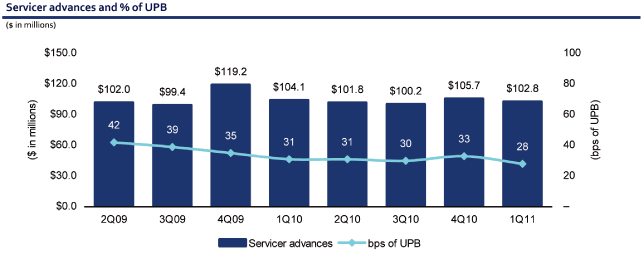
Green Tree’s experience moderating servicer advance exposure is in stark contrast to the rest of
the industry. Green Tree management has successfully limited the advance requirements it assumes on
new servicing portfolios. On the majority of portfolios acquired over the last two years, Green
Tree receives advance reimbursement within 30 days.
Licensing and servicer ratings
Green Tree has obtained licensing and approvals allowing it to maximize the size of its target market:
| • | Licensed or exempt from licensing in the 48 contiguous states |
|
| • | Approved Fannie Mae third-party special servicer |
|
| • | Green Tree’s servicing platform is rated by Moody’s, S&P and Fitch, and
Green Tree is one of few servicers to receive upgrades in the past year |
Green Tree ratings overview
| Ratings agency | Category | Rating | ||
Fitch
|
Special Servicer / Sub-prime | RPS2+ (upgraded 11/10) | ||
Fitch
|
HLTV / Second lien / HELOC (New) | RPS2 (affirmed (11/10) | ||
Moody’s
|
Sub-prime and Second liens | SQ2- (upgraded 1/10) | ||
Moody’s
|
Manufactured housing | SQ2 (affirmed 1/10) | ||
Standard & Poor’s
|
Sub-prime / HLTV / Special servicer | Above average — Select servicer (upgraded 1/10) |

|
Page 61 of 90 |
Asset receivables management
Product overview
Established in 2004 and located in Tempe, AZ and Cleveland, OH with 110 employees, the ARM
product involves pursuing collection of deficiency balances that result when the loan balance
exceeds proceeds from liquidating the collateral on a defaulted loan contract, or, in certain
instances, when a loan is charged off. Green Tree is engaged by securitization trusts and other
third party investors to pursue, where permitted by law, the collection of these deficiency
balances on a contingency fee basis. For the year ending December 31, 2010, this product generated
revenue of $30.1 million.
Due to the large growth opportunity that exists in this product, Green Tree began to increase its
focus on the ARM product in 2010 by hiring senior management, opening a new service center in
Cleveland and implementing a business development strategy to add new clients. Green Tree managed
an ARM portfolio of $7.8 billion (200,000 customers) as of March 31, 2011, an increase of 16% from
December 31, 2009. The portion of gross collections retained by Green Tree from third-party
collections ranges from 20%—40% of cash collected. As illustrated below, the product is growing
rapidly due to the large flow of new assets it has sourced recently. The business requires minimal
capital or credit risk exposure given it typically does not own the underlying collateral.
Key revenue drivers include:
| • | Fee based on percentage of cash collections from
charged-off receivable balances (typically 20-40% of cash
collections) |
|
| • | Growth of industry-wide charge-offs |
|
| • | Ability to enter new asset classes |
Rapidly growing product
Margins in the ARM product are high due to the structure of the contingency fees which allows
Green Tree to manage its expenses and staffing levels in proportion to expected revenue streams.

|
Page 62 of 90 |
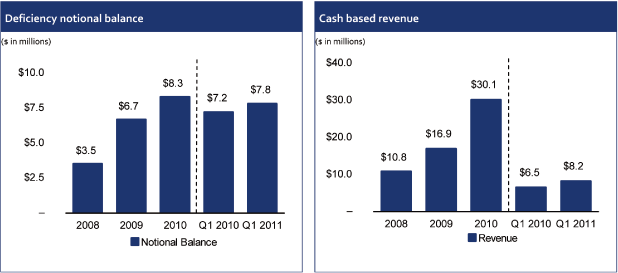
The ARM product is complementary to Green Tree’s third-party loan servicing product. The success of
the product is reliant on strong customer relationships, managing expenses and controlling risk
along all lines of compliance. New portfolios have historically been sourced through existing
servicing relationships, whereby the asset is collected throughout the loan life cycle without
system conversions or data transfer concerns, creating a seamless process. Green Tree recently
started focusing on stand-alone relationships in which ARM efforts are undertaken for loans where
Green Tree is not the primary servicer. Green Tree’s experience has been that new business is
awarded based on collection results, service and adherence to compliance procedures. Green Tree
expects the market opportunity for ARM to continue to grow due to elevated mortgage default rates
and the decline in home prices. The increasing market supply creates a counter-cyclical
opportunity to expand ARM. Green Tree recently entered into a contractual relationship with two
large national banks to receive monthly flow of charged off mortgage products. In addition, Green
Tree just recently executed a servicing agreement with a large hedge fund that focuses their
investment strategy on this asset class.
Product distribution
Opportunities exist to expand the product into other asset classes to take advantage of
existing infrastructure. The majority of the collections today are sourced by internal collectors
(48%) or via short sale transactions (31%). Green Tree expects that trend to continue over the
immediate future but revert to the margin percentage of internal collections over time.

|
Page 63 of 90 |
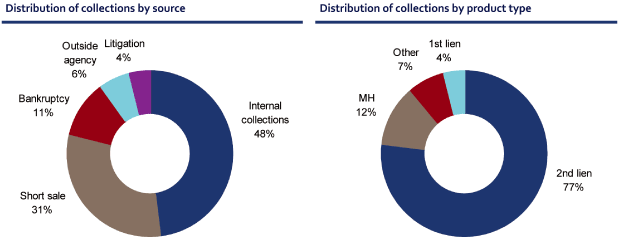
Business process
Green Tree employs a multi-pronged collections strategy using both internal and external
approaches driven by a score- and product-driven model. A schematic outlining the key processes
and strategies is below:
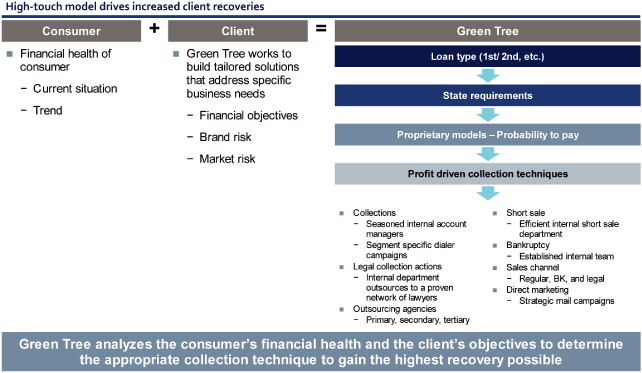

|
Page 64 of 90 |
D. Insurance agency
Business overview
Insurance Agency is licensed nationwide to sell and service primarily property and casualty
(“P&C”) insurance products on behalf of third-party insurance carriers. Insurance Agency acts as
an agent and does not underwrite the products nor adjudicate claims.
Established in 1975 initially to fulfill the lender-placed insurance needs of the related Loan
Servicing business, Insurance Agency eventually widened its offering to include voluntary products,
with an emphasis on manufactured homeowners’ insurance. Utilizing the affiliate relationship with
the Loan Servicing customers, and years of successful marketing and cross-selling, Insurance Agency
has achieved a 23.2% penetration of voluntary homeowners insurance on the MH serviced portfolio as
of March 2011.
As typical for the industry, owners of serviced loans and securitization trusts require borrowers
to maintain insurance coverage protecting the collateral securing the loan. In the event the
borrower fails to maintain the required insurance coverage, it is the responsibility of the
servicer to purchase adequate coverage on the borrowers’ behalf. This lender-placed coverage is
purchased exclusively through Insurance Agency, and penetrations of this coverage as of March 2011
were 23.3% on MH and 8.9% on 1st lien residential serviced portfolios.
Product offering
Insurance agency product offering overview
| Product | Description | |||||
Primary products
|
Voluntary Homeowners Insurance | • • |
Primarily written for Manufactured Housing today Typically 3-year policies |
|||
| • | Includes liability, accidental loss and flood insurance | |||||
| Lender Placed Homeowners Insurance (FP) |
• | “Force-placed” coverage by lender in event customer does not voluntarily carry homeowners insurance | ||||
| • | Protects 1st lien holder and is based upon the principal balance of the loan | |||||
| • | Required by the pooling and servicing agreement that services trade | |||||
Ancillary products
|
Life / Accidental Death | • | Decreasing term life insurance with monthly premium payment | |||
| • | Designed to pay an outstanding debt (i.e., mortgage balance) in the event of a borrower’s death | |||||
| Warranty / Service Contracts | • | Covers the various systems of the home: plumbing and electrical systems, central heating and air conditioning as well as original appliances included in the home after the manufacturer’s warranty expires | ||||
Other
|
Monthly Service Fees | • | Service fees for customers electing monthly payment plan | |||

|
Page 65 of 90 |
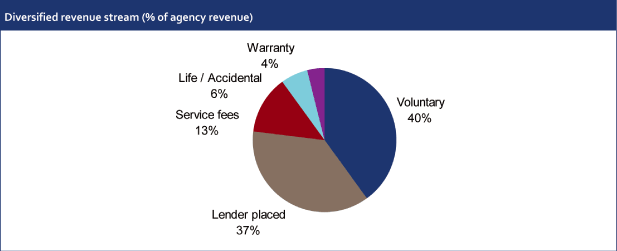
Key business drivers
The ability to solicit the existing MH and residential portfolio customers coupled with the
high penetration rates and retention associated with renewals of existing policies provide stable,
predictable revenue streams with a low expense base and minimal capital expenditures.
Key drivers of the segment’s performance are:
| • | Size of the servicing portfolio |
|
| • | Penetration rate |
|
| • | Average premium and commission rates |
The segment generated net written premiums of over $146 million in 2010. As a licensed agent to
our carriers, Insurance agency receives commissions as a percentage of net written premiums, as
well as ancillary revenues from selling other insurance products, service and billing fees, and
warranty and service contracts. There is no credit risk and virtually no collection risk on
insurance premiums as collections will be either from customers or from the securitization trust in
cases of borrower default.
As one of the largest writers of MH personal lines in the U.S., Insurance Agency has been able to
negotiate favorable payment terms with insurance carriers. This has allowed Green Tree to pay the
carriers based on a monthly payment schedule that mirrors customer billing for premiums (referred
to as “pay-as-you-go”). A large majority of Green Tree’s business has been transitioned to this
pay-as-you-go agreement.
Customers are billed in equal installments, including servicing fees, throughout the policy term.
Customers benefit from:
| • | High quality products tailored to their needs |
|
| • | Flood coverage, which is included with the typical P&C coverage for MH |
|
| • | Rates which can be locked in for up to three years |
|
| • | Direct billing of premiums on the customer’s monthly mortgage statement |

|
Page 66 of 90 |
Carriers
Green Tree uses two primary carriers for the Insurance Agency business:
| • | Primary insurance carrier partners are Assurant (NYSE: AIZ) and American Modern (owned by
Munich Re), which have histories of reliability, superior quality of service, and ample
financial resources |
|
| • | Both carriers are highly rated by A.M. Best, with Assurant rated A and American Modern rated A+ |
The carriers are long established in both the traditional residential and specialty MH market
segments. History and experience prove that both understand the industry and customer needs well.
Steady performance
Insurance Agency produces high returns and positive cash flows while maintaining a low cost
structure. Insurance Agency enhances the economics of the Loan Servicing business by utilizing the
customer base and platform to cross-sell additional services.
As illustrated in the charts below, the volume of earned premium has remained consistent over the
past several years driven by steady penetration rates and modest increases in per policy average
premiums.

Key statistics
| 2008 | 2009 | 2010 | Q1 2010 | Q1 2011 | ||||||||||||||||
1st lien loans serviced |
558,850 | 555,444 | 501,256 | 545,133 | 502,697 | |||||||||||||||
Voluntary penetration |
20.9 | % | 19.6 | % | 19.9 | % | 19.5 | % | 19.4 | % | ||||||||||
Force-placed penetration |
22.6 | % | 20.7 | % | 21.1 | % | 21.0 | % | 20.9 | % | ||||||||||
Average annual premium ($ per policy) |
$ | 760 | $ | 763 | $ | 823 | $ | 879 | $ | 881 | ||||||||||

|
Page 67 of 90 |
E. Other businesses
Two business lines were recently launched to further leverage Green Tree’s platform, providing
fee-for-service revenue streams and incremental cash flows: Investment Management and Third-Party
Originations.
Investment management
Established in 2008, Green Tree’s Investment Management business seeks out strategic
investment opportunities in mortgage assets and securities for the jointly managed SerVertis Fund.
Green Tree’s investment management expertise is utilized to help source, evaluate, diligence, price
and structure acquisitions, and to settle trades. Subsequently, Green Tree’s servicing platform is
leveraged to increase the value of the portfolio through loss mitigation techniques and
implementation of Green Tree’s superior servicing. The synergies with Loan Servicing allow for the
development and implementation of innovative servicing strategies and protocols, including early
delinquency intervention and customized servicing protocol based on the collection of robust
financial data including borrowers’ capacity to stay in their home, which have shown positive
results to date.
SerVertis key fund attributes
Strategy
|
• | Primary objective is to purchase distressed whole loans through secondary capital market channels | ||
| • | Green Tree has the right of first refusal on sub-servicing business from investments made by SerVertis Fund | |||
Capital raised / deployed
|
• | SerVertis raised/closed $1.4 billion of committed capital in August 2008 | ||
| • | $980 million of capital deployed through 12 whole loan transactions, acquiring $1.9 billion of UPB (through March 2011) | |||
Fund life
|
• | SerVertis Fund has a 3.5 year investment period and a 6-year final term with two 1-year extension options | ||
Fee structure
|
• | Base management fee: 2.0% | ||
| • | Incentive fee: 20% of cash returns over 8% hurdle with full catch up provision | |||
| • | Management and incentive fees are split 50/50 with partner | |||
Green Tree capital commitment
|
• | Green Tree has committed to invest up to $10 million in capital as a limited partner, of which $4.9 million is undrawn (through March 2011) |
As the following chart shows, the size of the SerVertis portfolio and the momentum of
acquisitions have both continued to increase through Q1 2011.

|
Page 68 of 90 |
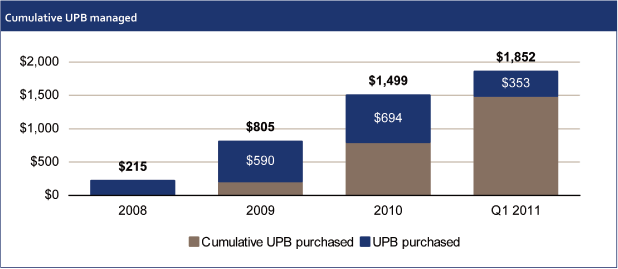
Third-party originations
Established in 2009, and based in Tustin, CA, Third-Party Originations provides financing and
loss mitigation solutions for Green Tree serviced loans. Green Tree operates the Third-Party
Originations business purely as a loss mitigation tool to maximize returns for loan owners of its
serviced portfolio. The group offers customized refinance campaigns that meet specific
requirements, such as reducing losses, increasing cash flows, and maximizing returns. A key benefit
to the business is from the Hope for Homeowners program, which encourages refinancing mortgages for
borrowers who have difficulty making payments, but can afford a new loan that qualifies under the
requirements of the Federal Housing Administration.
| • | 100% flow business, where all originations are funded with pre-approved take-out agreements with third parties |
|
| • | Revenue is generated based on volume of loans originated, closing and lender fees |
|
| • | No underwriting credit risk, including early payment default liability/risk, interest rate risk or hedging risk |
|
| • | Green Tree has a $4.75 million committed warehouse line to fund short-term originations |
Green Tree prescreens existing servicing customers for eligibility and identifies potential loan
modification opportunities where it is beneficial to initiate a customer payoff through a
refinancing. Green Tree leverages a proprietary loan performance database of 1.6 million loans to
support credit risk models and drive execution of complex refinancing strategies. Green Tree has
completed licensing requirements for originating and refinancing mortgage loans in 45 states.

|
Page 69 of 90 |
7. Management team

|
Page 70 of 90 |
7. Management team
The Walter and Green Tree management teams have experience executing the business through
multiple credit and housing cycles.
A. Walter
| Name | Title | Experience | ||
Mark J. O’Brien
|
Chairman and CEO | Mark J. O’Brien has served as the Chairman of the board of directors and Chief Executive Officer of Walter Investment since April 2009. In March 2006, Mr. O’Brien was named Chairman and Chief Executive Officer of the Walter Homebuilding and Financing business and, in February 2009, of Walter Investment Management LLC. He also served as a director of Walter Energy from 2005 until April 2009. Mr. O’Brien has served as President and Chief Executive Officer of Brier Patch Capital and Management, Inc., a real estate investment and management firm, since September 2004. Mr. O’Brien served in various capacities at Pulte Homes, Inc. for 21 years, culminating in his appointment as President and Chief Executive Officer. He retired from that position in 2003. Mr. O’Brien is also a director of Mueller Water Products, Inc. and serves on the Board of Trustees for The Billfish Foundation. | ||
Charles E. Cauthen
|
President and Chief Operating Officer | Mr. Cauthen has served as President and COO of Walter Investment since April 2009. Mr. Cauthen was Chief Financial Officer of the Walter Homebuilding and Financing business and President of Walter Mortgage Company from November 2006 until April 2009. Since November 2000, he served in a variety of roles for Walter Energy, including President of Jim Walter Homes, Interim President of U.S. Pipe and Foundry and Senior Vice President and Controller of Walter Energy. Prior to coming to Walter Energy, he held positions as Chief Financial Officer-Consumer Products Group, at Bank of America, Director of Corporate Development at Barnett Banks, and Audit Manager at Deloitte and Touche. Mr. Cauthen is a graduate of the University of Mississippi. | ||
Denmar J. Dixon
|
Vice Chairman of the Board and Executive Vice President | Mr. Dixon has been a member of the Walter Investment Board of Directors since April 2009 and has been Vice Chairman and EVP since February 2010. Prior thereto, Mr. Dixon was a private investor and founder and managing partner of Blue Flame Capital, LLC., a consulting, financial advisory and investment firm. Mr. Dixon retired in 2008 after 23 years with Bank of America. At the time of his retirement, Mr. Dixon was a Managing Director in the Corporate and Investment Banking group and Global Head of the Basic Industries group. During his career at Bank of America, Mr. Dixon completed mergers and acquisitions, equity and debt capital raising and financial restructuring transactions totaling in excess of $75 billion. | ||
Kimberly A. Perez
|
Vice President, Chief Financial Officer and Treasurer | Kimberly A. Perez has served as Vice President, Chief Financial Officer and Treasurer of the company since April 2009. She also was appointed Vice President of the Walter Homebuilding and Financing business in November 2006 and, as of February 2009, she held the same office in Walter Investment. She was appointed Executive Vice President and Chief Financial Officer of the Financial Services Group of Walter Energy in December 2002. Prior to this, she served as Vice President, Corporate Accounting for Walter Energy from 2000 to 2002, and before that she served as Assistant Controller — Director of Accounting and Strategic Planning for Walter Energy beginning in July 1997. Prior to her employment at Walter Energy, she was Audit Manager for PricewaterhouseCoopers LLP from 1989 to 1997. |

|
Page 71 of 90 |
| Name | Title | Experience | ||
Stuart D. Boyd
|
Vice President, General Counsel and Secretary | Mr. Boyd joined the Company in April 2009 after seventeen years at Key Safety Systems, Inc. (previously Breed Technologies, Inc.), the last seven years of which were served as the Senior Vice President, Legal, General Counsel and Secretary. Prior thereto he spent nine years in private legal practice. Mr. Boyd is a graduate of Dartmouth College and the University of Miami School of Law. | ||
Del M. Pulido
|
Vice President of Human Resources | Mr. Pulido joined the Company in 2005. Prior thereto, he was Vice President of Human Resources for Marconi Commerce Systems/Gilbarco, Inc. Mr. Pulido previously held various senior Human Resources positions with Citigroup, Inc. for 15 years and Seminole Electric Cooperative, Inc. for five years. Mr. Pulido is a graduate of the University of South Florida. |
B. Green Tree
| Name | Title | Experience | ||
Brian L. Libman
|
Chief Strategic Officer | Mr. Libman became Chief Executive Officer contemporaneously with the purchase of Green Tree from its prior owners on October 2007. His primary responsibilities include the development and overall execution of Green Tree’s corporate business plan. A 21 year veteran of the mortgage industry, Mr. Libman has held senior positions in various capacities. He was Chief Executive Officer of Finance America, LLC a national non-prime lender based in Irvine, California. Finance America emerged from a restructured Amresco Mortgage in 2000 which Mr. Libman led to profitability and then sold in 2004. Mr. Libman was a Managing Director and head of residential whole loan trading at Lehman Brothers, Inc., where he worked from 1988-1999. Mr. Libman formerly served on the board of directors of The Clayton Group, a mortgage advisory and analysis business based in Shelton, Connecticut. Mr. Libman earned both his Bachelors and MBA degrees with honors from the Wharton School of the University of Pennsylvania. | ||
Keith A. Anderson
|
President and Chief Executive Officer | Mr. Anderson’s 25 year career in financial services has included managing business strategies involving start-ups, restructuring of businesses, consolidations and growth focus. He is responsible for all aspects of Green Tree, including operations, financial performance, technology, and legal/compliance. Since joining Green Tree in 1995, Mr. Anderson has held various positions, including Chief Financial Officer, Treasurer, Chief Accounting Officer, Chief of Staff, and President of the Commercial Finance Group. His background covers a variety of finance product types from consumer credit cards to 1st lien residential loans to commercial lending. Prior to joining Green Tree, Mr. Anderson spent 8 years at Household International in its Home Equity, Private Label Credit Card Divisions and Corporate. Mr. Anderson started his career at Deloitte & Touche, spending 5 years as an audit supervisor, and holds a CPA. Mr. Anderson received a bachelor’s degree with honors in Accounting from Illinois State University and an MBA from DePaul University, Chicago. |

|
Page 72 of 90 |
| Name | Title | Experience | ||
James R. Breakey
|
Senior Vice President and Chief Information Officer | Mr. Breakey leads Green Tree’s technology organization and is responsible for all aspects of systems development and operations. Prior to joining Green Tree in 1997, Mr. Breakey was a Partner with Computer Sciences Corporation (CSC) where he specialized in management consulting for IT executives and business process reengineering. Before CSC, he spent ten years in various technology development and management roles at Portland General Electric. In all, Mr. Breakey has 28 years of leadership experience in the Technology Industry. He holds a master’s degree in Applied Systems Management from Marylhurst University and a bachelor’s degree in Computer Science from the University of North Dakota. | ||
Cheryl A. Collins
|
Senior Vice President, Chief Financial Officer |
Ms. Collins joined Green Tree in 1990 as Assistant Controller, and subsequently held the positions of Assistant Treasurer and Treasurer. In her current role as Senior Vice President and Chief Financial Officer, Ms. Collins is responsible for all financial operations including accounting, treasury, investor reporting, planning and tax. Prior to joining the Company, Ms. Collins spent five years at KPMG as an audit manager. Ms. Collins graduated with honors from Minnesota State University in Mankato, MN, and holds a bachelor’s degree in Accounting. Ms. Collins also holds a CPA. | ||
Patricia L. Cook
|
Executive Vice President, Business Development |
Ms. Cook is responsible for directing Green Tree’s business development efforts. Prior to joining Green Tree, Ms. Cook served as Executive Vice President and Chief Business Officer of Freddie Mac where she was responsible for the Single Family, Multi-Family and Investment and Capital Markets Divisions as well as corporate functions. Prior to joining Freddie Mac in August of 2004, she served as Managing Director and Chief Investment Officer for Fixed Income at JP Morgan Fleming Asset Management. Prior to JP Morgan, she held similar positions at Prudential Investment Management and Fisher Francis Trees & Watts. She began her career at Salomon Brothers in Fixed Income Sales and Trading. She holds a MBA from New York University and a bachelor’s degree from Saint Mary’s College. | ||
Brian F. Corey
|
General Counsel & Secretary |
Mr. Corey has 23 years of consumer lending and banking law experience. He advises Green Tree on the servicing, origination, acquisition, and securitization of loans, and on litigation, regulatory, insurance, bankruptcy and employment matters. Prior to joining Green Tree in 1995, Mr. Corey was a Vice President and assistant general counsel at ITT Consumer Financial Corporation. He was in private practice in Minneapolis before joining ITT in 1986. Mr. Corey is a member of the American Bar Association’s Consumer Financial Services Committee, the American Financial Services Association’s Law Committee, and the Governing Committee of The Conference on Consumer Finance Law. He graduated cum laude from the William Mitchell College of Law, St. Paul, Minn., and earned an undergraduate degree in physiology from the University of Minnesota, Twin Cities. | ||
Barbara J. Didrikson
|
Chief Human Resources Officer |
Ms. Didrikson is the senior vice president and chief human resources officer for Green Tree. She brings more than 24 years of human resources experience to her role. Before joining Green Tree in 1990, Ms. Didrikson managed human resources development for the New York Daily News and Minneapolis Star Tribune. She worked in several capacities with Donaldsons Department Stores over an eight-year period, including training and executive development. Ms. Didrikson has been certified as a Senior Professional in Human Resources (SPHR) by the Society for Human Resources Management. She holds a graduate certificate in human resources management from the University of St. Thomas in St. Paul, Minn., and a bachelor’s degree in social science/urban studies and economics from the College of St. Scholastica in Duluth, Minn. |

|
Page 73 of 90 |
| Name | Title | Experience | ||
Jeffrey A. Hilligoss
|
Executive Vice President of Capital Markets | As EVP of Capital Markets, Mr. Hilligoss is responsible for the development and leadership of Green Tree’s investment management business. Mr. Hilligoss brings 21 years of leadership and principal investment experience in the structured finance, ABS and RMBS markets to the Green Tree team. Prior to joining Green Tree in 2007, Mr. Hilligoss spent seven years as a Managing Director at GMAC-RFC (a unit of GMAC ResCap) in a variety of leadership positions, most recently leading the Principal Investment Activities business unit. Previously, Mr. Hilligoss held senior leadership, principal investment and investment banking positions at Cargill Financial Services Corp., USBank and HSBC. Mr. Hilligoss holds a bachelor of science degree in biochemistry from Indiana University, an MBA from the Tepper School of Business at Carnegie Mellon University and is a graduate of the Wharton/Spencer Stuart Director’s Institute at the University of Pennsylvania. | ||
Thomas J. Franco
|
Executive Vice President of Servicing | Tom Franco is an expert on consumer credit and collection management with 27 years of financial industry experience. He leads Green Tree’s Servicing business, which includes a servicing portfolio of $33 billion in assets. Prior to his current position, Mr. Franco served as President of the Manufactured Housing Division (MHD), Executive Vice President and Chief Operating Officer of MHD’s Servicing Operations, and as Senior Vice President and Chief Credit Officer with oversight of the Home Equity, Bankcard, Home Improvement, Private Label Retail Cards and Consumer Finance divisions. Mr. Franco previously worked with such leading financial companies as Banc One Corporation, Household International, ContiMortgage, and Citicorp. Mr. Franco graduated from the University of Southern Mississippi, Hattiesburg, Miss., with a bachelor’s degree from the School of Professional Accounting. He is also active in the Executive Education Program at Northwestern University’s Kellogg Graduate School of Management, Evanston, Ill. |

|
Page 74 of 90 |
8. Historical financial results

|
Page 75 of 90 |
8. Historical financial results
Walter historical GAAP balance sheet
($ in millions)
| As of | ||||||||
| 12/31/ 09 | 12/31/ 10 | |||||||
Assets |
||||||||
Cash and cash equivalents |
$ | 99.3 | $ | 114.4 | ||||
Restricted cash and cash equivalents |
51.7 | 52.3 | ||||||
Receivables, net |
3.1 | 2.7 | ||||||
Subservicer advances and receivables, net |
— | 11.2 | ||||||
Residential loans, net of allowance for loan losses |
1,644.3 | 1,621.5 | ||||||
Subordinate security |
1.8 | 1.8 | ||||||
Real estate owned |
63.1 | 67.6 | ||||||
Deferred debt issuance costs |
18.4 | 19.4 | ||||||
Deferred income tax asset, net |
— | 0.2 | ||||||
Other assets |
6.0 | 4.4 | ||||||
Total assets |
$ | 1,887.7 | $ | 1,895.5 | ||||
Liabilities |
||||||||
Accounts payable |
$ | 29.9 | $ | 33.6 | ||||
Dividends payable |
13.2 | 13.4 | ||||||
Deferred income tax liability, net |
0.2 | — | ||||||
Mortgage-backed debt |
1,267.5 | 1,281.6 | ||||||
Warehouse and other servicer liabilities |
— | 3.3 | ||||||
Accrued interest |
8.8 | 8.1 | ||||||
Total liabilities |
$ | 1,319.5 | $ | 1,340.0 | ||||
Stockholders’ equity |
$ | 568.2 | $ | 555.5 | ||||

|
Page 76 of 90 |
Walter historical GAAP income statement
| ($ in millions) |
| For the fiscal year ended, | ||||||||
| 12/31/09 | 12/31/10 | |||||||
Net interest income |
||||||||
Interest income |
$ | 175.3 | $ | 166.1 | ||||
Interest expense |
89.7 | 82.7 | ||||||
Total net interest income |
$ | 85.6 | $ | 83.4 | ||||
Provision for loan losses |
9.4 | 6.5 | ||||||
Total net interest income after provision for loan losses |
$ | 76.2 | $ | 76.9 | ||||
Non-interest income |
||||||||
Premium revenue |
$ | 10.1 | $ | 9.1 | ||||
Servicing revenue and fees |
— | 2.3 | ||||||
Other income |
2.9 | 3.3 | ||||||
Total non-interest income |
$ | 13.0 | $ | 14.7 | ||||
Non-interest expenses |
||||||||
Claims expense |
$ | 4.5 | $ | 2.3 | ||||
Salaries and benefits |
20.6 | 27.5 | ||||||
Legal and professional |
4.2 | 3.8 | ||||||
Occupancy |
1.4 | 1.5 | ||||||
Technology and communication |
3.0 | 3.0 | ||||||
Depreciation and amortization |
0.4 | 0.4 | ||||||
General and administrative |
11.0 | 12.6 | ||||||
Real estate owned expenses, net |
5.7 | 6.5 | ||||||
Other non-interest expenses |
0.8 | (4.3 | ) | |||||
Total non-interest expenses |
$ | 51.6 | $ | 53.3 | ||||
Income before income taxes |
$ | 37.6 | $ | 38.2 | ||||
Income tax expense |
(76.2 | ) | 1.3 | |||||
Net income |
$ | 113.8 | $ | 37.0 | ||||
Walter management’s discussion and analysis summary
Net interest income
Walter’s results of operations for its portfolio during a given period typically reflect the net
interest spread earned on the Company’s residential loan portfolio. The net interest spread is
impacted by factors such as the interest rate Walter’s residential loans are earning and the
Company’s cost of funds. Furthermore, the amount of discount on the residential loans will impact
the net interest spread as such amounts will be amortized over the expected term of the residential
loans and the amortization will be accelerated due to voluntary prepayments.
The following table summarizes the average balance, interest and weighted average yield on
residential loan assets and mortgage-backed debt for the periods indicated.

|
Page 77 of 90 |
($ in millions)
| For the twelve months ended December 31, | ||||||||||||||||||||||||
| 2009 | 2010 | |||||||||||||||||||||||
| Average | Average | |||||||||||||||||||||||
| balance | Interest | Yield | balance | Interest | Yield | |||||||||||||||||||
Interest-bearing assets |
||||||||||||||||||||||||
Residential loans |
$ | 1,726.3 | $ | 175.4 | 10.16 | % | $ | 1,649.7 | $ | 166.2 | 10.07 | % | ||||||||||||
Interest-bearing liabilities |
||||||||||||||||||||||||
Mortgage-backed debt |
$ | 1,320.1 | $ | 89.7 | 6.80 | % | $ | 1,274.5 | $ | 82.7 | 6.49 | % | ||||||||||||
Net interest spread (1) |
85.6 | 3.36 | % | 83.5 | 3.58 | % | ||||||||||||||||||
Net interest margin (2) |
4.96 | % | 5.06 | % | ||||||||||||||||||||
| (1) | Net interest spread is calculated by subtracting the weighted average yield on
interest-bearing liabilities from the weighted average yield on interest-earning assets. |
|
| (2) | Net interest margin is calculated by dividing the net interest spread by total average
interest-earning assets. |
Net interest spread
Net interest spread of 3.58% for the year ended December 31, 2010 increased as compared to 3.36% in
the same period of 2009, due primarily to a decrease in interest expense, lower levels of
non-accrual assets, and higher yields on recently acquired residential loans, partially offset by a
decrease in voluntary prepayments. The decrease in interest expense is due to lower average
outstanding borrowings as a result of principal payments on the mortgage-backed debt, a $36.2
million mortgage-backed debt extinguishment offset by the increase to the outstanding balance as a
result of the current year securitization at a yield of 4.56%. The average prepayment rate for the
portfolio was 2.3% for the year ended December 31, 2010, as compared to 3.3% in the same period of
2009.
Net interest margin
Net interest margin increased for the year ended December 31, 2010 as compared to the same periods
in 2009 due to lower levels of non-accrual assets and lower average outstanding mortgage-backed
debt balances, partially offset by a decrease in prepayment speeds.
Provision for loan losses
The decrease in the provision for loan losses for the year ended December 31, 2010, as compared to
the same period in the previous year was primarily due to reduced frequency of default offset by a
modest increase in loss severities. Additionally, as the amount of residential loans decreases and
as the loans season, the credit exposure is reduced, resulting in decreasing provisions.
Non-interest income
The increase in non-interest income for the year ended December 31, 2010, as compared to the same
period in the previous year was primarily due to servicing revenue and fees and the bargain
purchase of approximately $0.4 million as a result of the acquisition of Marix in November 2010
offset by lower earned premiums from Walter’s insurance business.
Non-interest expenses
The increase in non-interest expenses for the year ended December 31, 2010, as compared to the same
period in the previous year, was primarily due to additional non-interest expenses of $3.5 million
from Marix acquisition related charges and operating costs for the two month period since the
acquisition date,
an increase in salaries and benefits due to growth initiatives, an increase in REO expenses, net,
offset by a decrease in claims expense as a result of fewer active policies and better claims
experience in Walter’s insurance business, as well as gains on mortgage-backed debt extinguishment
of $4.3 million. The increase in salaries and benefits due to growth initiatives was driven by the
addition of employees to support the stand-alone company, additional stock compensation expense, as
well as severance costs incurred in 2010.

|
Page 78 of 90 |
Income taxes
The change in income tax expense for the year ended December 31, 2010, as compared to income tax
benefit for the same period in the previous year was due to the impact of Walter’s becoming
qualified as a REIT in conjunction with the spin-off from Walter Energy and merger with Hanover.
Green Tree historical GAAP balance sheet
($ in millions)
| As of | ||||||||
| 12/31/ 09 | 12/31/ 10 | |||||||
Assets |
||||||||
Cash and cash equivalents |
$ | 29.0 | $ | 54.3 | ||||
Restricted cash |
144.5 | 149.6 | ||||||
Insurance premium receivables |
130.3 | 121.9 | ||||||
Loans related to VIE |
— | 608.3 | ||||||
Receivables related to VIE |
— | 121.8 | ||||||
Servicing rights |
239.0 | 208.0 | ||||||
Servicer advances |
105.6 | 82.4 | ||||||
Intangible assets |
62.3 | 51.5 | ||||||
Other assets |
87.6 | 95.4 | ||||||
Total assets |
$ | 798.3 | $ | 1,493.2 | ||||
Liabilities |
||||||||
Collateralized borrowings |
$ | 421.2 | $ | 371.3 | ||||
Bonds payable related to VIE |
— | 792.1 | ||||||
Escrow payable |
70.9 | 56.2 | ||||||
Payable to insurance carriers |
59.0 | 53.2 | ||||||
Payable to trusts / investors |
73.6 | 76.5 | ||||||
Other liabilities |
166.9 | 88.5 | ||||||
Total liabilities |
$ | 791.6 | $ | 1,437.8 | ||||
Member’s equity |
$ | 6.7 | $ | 55.4 | ||||

|
Page 79 of 90 |
Green Tree historical GAAP income statement
($ in millions)
| For the fiscal year ended, | ||||||||
| 12/31/09 | 12/31/ 10 | |||||||
Revenues |
||||||||
Servicing income |
$ | 228.0 | $ | 239.4 | ||||
Change in fair value of assets related to consolidated VIEs |
— | 97.4 | ||||||
Commission income |
54.9 | 53.9 | ||||||
Ancillary servicing income |
30.0 | 40.9 | ||||||
Other income |
30.6 | 36.9 | ||||||
Total revenues |
$ | 343.5 | $ | 468.5 | ||||
Expenses |
||||||||
Interest expense |
$ | 44.0 | $ | 42.6 | ||||
Change in fair value of bonds payable related to consolidated VIEs |
— | 95.0 | ||||||
Salaries and benefits |
129.5 | 147.8 | ||||||
Other operating costs and expenses |
71.0 | 87.3 | ||||||
Change in fair value of servicing rights |
34.7 | 12.3 | ||||||
Impairment (recovery of) charges |
(5.6 | ) | 1.0 | |||||
Total expenses |
$ | 273.6 | $ | 386.0 | ||||
Net income before taxes |
$ | 69.9 | $ | 82.5 | ||||
Income taxes |
10.9 | 11.4 | ||||||
Net income |
$ | 59.0 | $ | 71.1 | ||||
Green Tree management’s discussion and analysis summary
Revenues
Servicing income
Servicing income increased by $11.4 million, or 5.0%, to $239.4 million for the year ended December
31, 2010, compared to $228.0 million for the year ended December 31, 2009. Servicing income,
excluding the impact of the consolidation of Variable Interest Entities (“VIEs”), for the year
ended December 31, 2010 was $250.1 million, an increase of 9.8%. The servicing revenue increase is
due to higher contractual servicing income related to the growth in the average UPB serviced which
grew from $25.7 billion for the year ended December 31, 2009 to $33.3 billion for the year ended
December 31, 2010. Servicing income also increased $9.9 million due to higher incentive fees
earned year over year.
Commission income
Commission income on the insurance policies sold by Green Tree’s insurance agency business
decreased by $1.0 million, or 1.8%, to $53.9 million for the year ended December 31, 2010 as
compared to $54.9 million for the year ended December 31, 2009. The decrease is primarily due to a
0.3% decrease in net written premiums to $146.8 million for the year ended December 31, 2010 from
$147.3 million for the year ended December 31, 2009 as a result of the continued runoff of the MH
servicing portfolio.

|
Page 80 of 90 |
Ancillary servicing income
Ancillary servicing income increased by $10.9 million, or 36.3%, to $40.9 million for the year
ended December 31, 2010 as compared to $30.0 million for the year ended December 31, 2009. The
increase is primarily due to $9.5 million of fees earned for successful loan modifications under
the new government home modification program (HMP) and other modification programs in 2010.
Other income
Other income increased by $6.3 million, or 20.6%, to $36.9 million for the year ended December 31,
2010 as compared to $30.6 million for the year ended December 31, 2009.
Other income includes (i) income from the asset receivables management (“ARM”) business (see
below); (ii) management fees from the investment management business; (iii) accretion on legacy
assets purchased at a discount; and (iv) $2.7 million of losses on repossessed trust assets related
to the consolidated VIEs.
Income from the ARM business increased by $13.2 million to $30.8 million for the year ended
December 31, 2010 as compared to the year ended December 31, 2009. This growth is a result of an
increase in both the average notional balance serviced which increased from $5.0 billion for the
year ended December 31, 2009 to $7.7 billion for the year ended December 31, 2010, and an increase
in the ratio of gross collections on average notional balances to 1.3% from 1.0% in 2009.
Expenses
Interest expense
Interest expense decreased by $1.4 million, or 3.2%, to $42.6 million for the year ended December
31, 2010 compared to $44.0 million for the year ended December 31, 2009. The decrease in accretion
on discounted liabilities is mainly attributed to the elimination of the contingent liability
associated with the mandatory repurchase obligation as a result of the implementation of FAS 167.
The decrease in the servicer advance facility was due to the fact the previous servicer advance
facility was terminated in the third quarter of 2009 resulting in the recognition of deferred debt
costs and an early termination fee.
The following table details the components of interest expense:
GTCS interest expense
($ in millions)
| For the fiscal year ended, | 2009-2010 | |||||||||||
| 12/31/09 | 12/31/ 10 | Change | ||||||||||
Senior secured credit agreements |
$ | 23.9 | $ | 34.0 | $ | 10.1 | ||||||
Accretion of discounted liabilities |
10.2 | 3.1 | (7.1 | ) | ||||||||
Servicer advance facility |
9.8 | 4.7 | (5.1 | ) | ||||||||
MSR financing facility |
0.1 | 0.8 | 0.7 | |||||||||
Total expenses |
$ | 44.0 | $ | 42.6 | $ | (1.4 | ) | |||||
Salaries and benefits
Salaries and benefits increased by $18.3 million, or 14.1%, to $147.8 million for the year ended
December 31, 2010 compared to $129.5 million for the year ended December 31, 2009. Included in
Salaries and benefits is an expense push down from Green Tree’s parent, GTH LLC, related to an
equity compensation program at the parent entity of $5.3 million for the year ended December 31,
2010 and $6.7 million for
the year ended December 31, 2009. This expense is offset by a credit to Members’ equity, as it
does not represent a liability of GTCS. Excluding this expense push down, salaries and benefits
increased by 16.0% to $142.5 million for the year ended December 31, 2010 compared to $122.8
million for the year ended December 31, 2009. During this same time frame, the average number of
employees grew 10.2%, from 1,667 to 1,837 related primarily to the growth in the servicing and ARM
businesses.

|
Page 81 of 90 |
Other operating costs and expenses
Other operating costs and expenses increased by $16.3 million, or 23.0%, to $87.3 million for the
year ended December 31, 2010, compared to $71.0 million for the year ended December 31, 2009. The
majority of this increase relates to the costs associated with the growth in the number of accounts
serviced by Green Tree and an increase in certain fees associated with servicing GSE
portfolios. $3.4 million of the increase is related to higher amortization expense for the mortgage
servicing rights from purchases in late 2009.
Change in fair value of MH servicing rights
Change in fair value of MH servicing rights was an expense of $12.3 million for the year ended
December 31, 2010 compared to an expense of $34.7 million for the year ended December 31, 2009.
Green Tree’s MH servicing rights are accounted for on a fair value basis. The change in fair value
of MH servicing rights is comprised of 2 components: (i) amortization for the realization of cash
flows and (ii) adjustments to valuation assumptions based on changes in expected future
performance.
The amortization component decreased by $8.8 million to $35.7 million for the year ended December
31, 2010 from $44.5 million for the year ended December 31, 2009 due to the runoff of the MH
serviced portfolio balance. The adjustment related to changes in valuation assumptions resulted in
a benefit for the year ended December 31, 2010 of $23.4 million as compared to a benefit of $9.8
million for the year ended December 31, 2009. In 2010 a 4 basis point adjustment was made to reduce
the near term cost to service assumption. Additionally, both 2010 and 2009 reflect benefits from
adjustments in valuation related to reductions in Constant Default Rate (“CDR”) and Constant
Repayment Rate (“CRR”) assumptions. CDR assumptions were reduced by approximately 20 basis points
in both 2010 and 2009, and are currently at 3.9%. CRR assumptions were reduced by approximately 60
basis points and 40 basis points, respectively, in 2010 and 2009, and are currently at 2.9%.
Impairment charges
Impairment charges were $1.0 million for the year ended December 31, 2010, while 2009 included a
recovery of impairment of $5.6 million. The 2010 impairment charge was due to an increase in our
severity assumption of approximately 8 points related to our mandatory repurchase obligation. The
recovery in 2009 is primarily due to a reversal of impairment taken in a prior period related to
Green Tree’s liability for mandatory call obligations.
Change in fair value of assets related to consolidated variable interests and change in fair value
of bonds payable related to consolidated variable interests
Change in fair value of assets related to consolidated variable interests and change in fair value
of bonds payable related to consolidated variable interests resulted in $97.4 million of income and
$95.0 million of expense, respectively, for the year ended December 31, 2010. The change in fair
value of these assets and liabilities primarily represents the interest accretion, or yield, on the
discounted cash flows supporting the valuation of these assets and liabilities for the period.

|
Page 82 of 90 |
The consolidation of the variable interest entities in accordance with FAS 167 resulted in
changes to assets, liabilities and equity as of January 1, 2010 as detailed in the following table:
($ in millions)
| Added to | Removed from | |||||||
| balance sheet | balance sheet | |||||||
Restricted cash |
$ | 16.2 | — | |||||
Loans related to consolidated variable interests |
664.3 | — | ||||||
Receivables related to consolidated variable interests |
141.9 | — | ||||||
Servicing rights |
— | (12.9 | ) | |||||
Servicer and protective advances |
— | (8.5 | ) | |||||
Servicing fee receivable (1) |
— | (1.0 | ) | |||||
Repossessed assets related to consolidated variable interests (2) |
4.6 | — | ||||||
Bonds payable related to consolidated variable interests |
(860.6 | ) | — | |||||
Mandatory clean-up calls on certain securitizations (3) |
— | 54.1 | ||||||
Payable to trusts/investors |
— | 1.9 | ||||||
Net equity impact |
$ | (33.6 | ) | $ | 33.6 | |||
| (1) | Servicing fee receivable was included in other assets on Green Tree’s consolidated balance
sheet. |
|
| (2) | Repossessed assets related to consolidated variable interests are included in other assets on
Green Tree’s consolidated balance sheet. |
|
| (3) | Mandatory clean-up calls on certain securitizations were included in other liabilities on
Green Tree’s consolidated balance sheet. |
Walter operating performance
($ in millions)
| 2009 | 2010 | Q1 2010 | Q1 2011 | |||||||||||||
Operations |
||||||||||||||||
Servicing income |
$ | 21.2 | $ | 21.8 | $ | 5.2 | $ | 7.3 | ||||||||
Premium revenue |
12.8 | 11.0 | 2.2 | 3.9 | ||||||||||||
Other revenue |
0.9 | 2.6 | 0.4 | 0.7 | ||||||||||||
Total revenue |
$ | 34.9 | $ | 35.4 | $ | 7.8 | $ | 11.9 | ||||||||
Direct costs |
(22.3 | ) | (22.6 | ) | (5.0 | ) | (8.1 | ) | ||||||||
Gross profit |
$ | 12.6 | $ | 12.8 | $ | 2.8 | $ | 3.8 | ||||||||
% margin |
36.1 | % | 36.2 | % | 35.4 | % | 32.2 | % | ||||||||
Loans and residuals |
||||||||||||||||
Interest income |
$ | 140.8 | $ | 132.0 | $ | 34.8 | $ | 34.1 | ||||||||
Interest expense |
(89.5 | ) | (81.6 | ) | (21.0 | ) | (20.3 | ) | ||||||||
Net interest margin |
$ | 51.3 | $ | 50.4 | $ | 13.8 | $ | 13.8 | ||||||||
Direct expenses |
(12.8 | ) | (17.1 | ) | (1.5 | ) | (1.6 | ) | ||||||||
Residual cash flow |
19.3 | 24.5 | 2.8 | 4.4 | ||||||||||||
Total cash flow |
$ | 57.8 | $ | 57.8 | $ | 15.1 | $ | 16.6 | ||||||||
Indirect expenses |
(21.7 | ) | (23.1 | ) | (8.7 | ) | (11.2 | ) | ||||||||
Operating cash flow |
$ | 48.7 | $ | 47.5 | $ | 9.2 | $ | 9.2 | ||||||||
Accrual adjustments |
3.9 | 0.7 | 0.9 | (0.4 | ) | |||||||||||
Adjusted EBITDA |
$ | 52.6 | $ | 48.2 | $ | 10.1 | $ | 8.8 | ||||||||
Note: Excludes transaction related costs. |

|
Page 83 of 90 |
Walter key performance metrics
($ in millions)
| 2009 | 2010 | Q1 2010 | Q1 2011 | |||||||||||||
Servicing UPB (1) |
||||||||||||||||
Total UPB |
||||||||||||||||
UPB beginning balance |
$ | 1,965 | $ | 1,820 | $ | 1,820 | $ | 1,804 | ||||||||
New additions |
8 | 100 | — | 63 | ||||||||||||
Run-off |
(153 | ) | (116 | ) | (27 | ) | (17 | ) | ||||||||
Ending balance |
$ | 1,820 | $ | 1,804 | $ | 1,793 | $ | 1,850 | ||||||||
Run-off (% of beginning balance) (2) |
(7.8 | %) | (6.4 | %) | (5.9 | %) | (3.8 | %) | ||||||||
Insurance |
||||||||||||||||
Insurance agency policies |
14,400 | 13,600 | 14,500 | 14,300 | ||||||||||||
Equity in portfolio assets |
||||||||||||||||
Securitized loans |
$ | 136 | $ | 338 | $ | 135 | $ | 330 | ||||||||
Unencumbered loans |
356 | 123 | 353 | 174 | ||||||||||||
Total |
$ | 492 | $ | 461 | $ | 488 | $ | 504 | ||||||||
| (1) | Servicing UPB relates to Walter’s owned portfolio and excludes Marix third party servicing
portfolio which was acquired in November 2010. |
|
| (2) | Annualized. |
Green Tree operating performance
($ in millions)
| 2008 | 2009 | 2010 | Q1 2010 | Q1 2011 | ||||||||||||||||
Servicing fee |
$ | 205.8 | $ | 226.1 | $ | 248.1 | $ | 62.7 | $ | 58.9 | ||||||||||
Late fees, ancillary, and other income |
22.0 | 19.8 | 29.7 | 6.3 | 8.7 | |||||||||||||||
ARM revenue |
10.8 | 16.9 | 30.1 | 6.5 | 8.2 | |||||||||||||||
Total servicing revenue |
$ | 238.6 | $ | 262.8 | $ | 307.9 | $ | 75.5 | $ | 75.8 | ||||||||||
Insurance agency |
72.5 | 69.3 | 64.8 | 17.6 | 18.3 | |||||||||||||||
Other businesses |
0.7 | 4.8 | 6.6 | 1.5 | 2.1 | |||||||||||||||
Total revenue |
$ | 311.8 | $ | 336.9 | $ | 379.3 | $ | 94.6 | $ | 96.2 | ||||||||||
Direct costs |
(122.7 | ) | (132.6 | ) | (149.7 | ) | (41.2 | ) | (42.7 | ) | ||||||||||
Gross profit |
$ | 189.1 | $ | 204.3 | $ | 229.6 | $ | 53.4 | $ | 53.5 | ||||||||||
% margin (1) |
60.6 | % | 60.6 | % | 60.5 | % | 56.5 | % | 55.6 | % | ||||||||||
Indirect expenses |
(43.9 | ) | (46.9 | ) | (57.1 | ) | (20.4 | ) | (21.2 | ) | ||||||||||
Operating cash flow |
$ | 145.2 | $ | 157.4 | $ | 172.5 | $ | 33.0 | $ | 32.3 | ||||||||||
Accrual adjustments |
(7.1 | ) | (6.4 | ) | (1.1 | ) | 9.6 | 13.6 | ||||||||||||
Adjusted EBITDA |
$ | 138.1 | $ | 151.0 | $ | 171.4 | $ | 42.6 | $ | 45.9 | ||||||||||
| (1) | Gross profit margins in Q1 2010 and Q1 2011 are reduced as a result of cash bonuses paid in
the first quarter of each year. |

|
Page 84 of 90 |
Green Tree key performance metrics
($ in millions)
| 2008 | 2009 | 2010 | Q1 2010 | Q1 2011 | ||||||||||||||||
Servicing UPB |
||||||||||||||||||||
Manufactured housing |
||||||||||||||||||||
UPB beginning balance |
$ | 17,225 | $ | 17,300 | $ | 15,426 | $ | 15,426 | $ | 13,633 | ||||||||||
New additions |
2,143 | 57 | 41 | 13 | — | |||||||||||||||
Run-off |
(2,068 | ) | (1,931 | ) | (1,834 | ) | (455 | ) | (406 | ) | ||||||||||
Ending balance |
$ | 17,300 | $ | 15,426 | $ | 13,633 | $ | 14,984 | $ | 13,227 | ||||||||||
Run-off (% of beginning balance) (1) |
(12.0 | %) | (11.2 | %) | (11.9 | %) | (11.8 | %) | (11.9 | %) | ||||||||||
Residential Mortgages & Other |
||||||||||||||||||||
UPB beginning balance |
$ | 2,926 | $ | 5,930 | $ | 18,772 | $ | 18,772 | $ | 18,374 | ||||||||||
New additions |
4,088 | 15,408 | 3,012 | 844 | 5,910 | |||||||||||||||
Run-off |
(1,084 | ) | (2,566 | ) | (3,410 | ) | (813 | ) | (924 | ) | ||||||||||
Ending balance |
$ | 5,930 | $ | 18,772 | $ | 18,374 | $ | 18,803 | $ | 23,360 | ||||||||||
Run-off (% of beginning balance) (1) |
(37.1 | %) | (43.3 | %) | (18.2 | %) | (17.3 | %) | (20.1 | %) | ||||||||||
Total UPB |
||||||||||||||||||||
UPB beginning balance |
$ | 20,151 | $ | 23,230 | $ | 34,199 | $ | 34,199 | $ | 32,009 | ||||||||||
New additions |
6,231 | 15,465 | 3,053 | 857 | 5,910 | |||||||||||||||
Run-off |
(3,152 | ) | (4,496 | ) | (5,243 | ) | (1,268 | ) | (1,329 | ) | ||||||||||
Ending balance |
$ | 23,230 | $ | 34,199 | $ | 32,009 | $ | 33,788 | $ | 36,590 | ||||||||||
Run-off (% of beginning balance) (1) |
(15.6 | %) | (19.4 | %) | (15.3 | %) | (14.8 | %) | (16.6 | %) | ||||||||||
Ending number of accounts |
659,362 | 720,089 | 666,721 | 706,234 | 738,440 | |||||||||||||||
ARM |
||||||||||||||||||||
Notional balance |
$ | 3,505 | $ | 6,675 | $ | 8,289 | $ | 7,230 | $ | 7,820 | ||||||||||
Insurance |
||||||||||||||||||||
Insurance agency policies |
243,082 | 223,992 | 205,872 | 220,921 | 202,501 | |||||||||||||||
| (1) | Annualized. |

|
Page 85 of 90 |
Combined LTM 3/31/11 operating performance
Going forward, Walter’s portfolio will run off and the Company will predominantly be a
fee-for-service business, capitalizing on the current favorable market opportunities for special
servicing. Significant cost synergies can be achieved as certain servicing functions are expected
to be absorbed by Green Tree. Additional cost synergies will be achieved from overlapping business
lines / shared services.
($ in millions)
| LTM 3/31/ 11 | ||||||||||||||||||||
| Walter | ||||||||||||||||||||
| Green Tree | Actual | Adjustments | Adjusted | Combined | ||||||||||||||||
Servicing fee |
$ | 244.3 | $ | 20.3 | — | $ | 20.3 | $ | 264.6 | |||||||||||
Late fees, ancillary, and other income |
32.1 | 3.6 | (3.6 | )(1) | — | 32.1 | ||||||||||||||
ARM revenue |
31.7 | — | — | — | 31.7 | |||||||||||||||
Total servicing revenue |
$ | 308.1 | $ | 23.9 | $ | (3.6 | ) | $ | 20.3 | $ | 328.4 | |||||||||
Insurance revenue |
65.5 | 12.7 | — | 12.7 | 78.2 | |||||||||||||||
Other revenue |
7.2 | 2.9 | — | 2.9 | 10.1 | |||||||||||||||
Total revenue |
$ | 380.8 | $ | 39.5 | $ | (3.6 | ) | $ | 35.9 | $ | 416.7 | |||||||||
Direct costs |
(151.2 | ) | (25.6 | ) | 3.6 | (1) | (22.0 | ) | (173.2 | ) | ||||||||||
Gross profit |
$ | 229.6 | $ | 13.9 | — | $ | 13.9 | $ | 243.5 | |||||||||||
% margin |
60.3 | % | 35.2 | % | NM | 38.7 | % | 58.4 | % | |||||||||||
Residual cash flow |
— | $ | 59.1 | $ | (10.2 | )(2) | $ | 48.9 | $ | 48.9 | ||||||||||
Indirect expenses |
(57.8 | ) | (25.6 | ) | 3.2 | (1) | (22.4 | ) | (80.2 | ) | ||||||||||
Synergies |
— | — | 19.0 | 19.0 | 19.0 | |||||||||||||||
Operating cash flow |
$ | 171.8 | $ | 47.4 | $ | 12.0 | $ | 59.4 | $ | 231.2 | ||||||||||
Accrual adjustments |
2.9 | (0.5 | ) | — | (0.5 | ) | 2.4 | |||||||||||||
Adjusted EBITDA |
$ | 174.7 | $ | 46.9 | $ | 12.0 | $ | 58.9 | (3) | $ | 233.6 | (4) | ||||||||
| (1) | Reflects elimination of Marix results since date of acquisition (November 2010) which are
reflected for a full year at expected levels in the synergy adjustment. |
|
| (2) | Reflects impact of monetization of owned bonds and unencumbered assets. |
|
| (3) | Walter adjusted EBITDA before synergies is equal to $39.9 million. |
|
| (4) | Adjusted EBITDA does not reflect the deduction of a full year of principal and interest
totaling approximately $23.1 million related to Walter’s 2010-1 securitization. |
Synergies
The Company has identified approximately $30 million of annual cost synergies and $19 million
of annual net synergies that it expects to realize on a pro forma basis. The cost to realize these
synergies is expected to be a one-time cost of $15 million.
| • | Sources of synergies: |
| • | Overlapping staff and administrative functions |
||
| • | Duplicative servicing platforms / business segments |
||
| • | Cross deploying proprietary technology to avoid planned future expenditures |

|
Page 86 of 90 |
($ in millions)
| Synergies | ||||
Walter / Green Tree synergies |
$ | 12.0 | ||
Marix synergies |
18.0 | |||
Cost synergies identified |
$ | 30.0 | ||
Revenue runoff of Marix |
(11.0 | ) | ||
Net synergies |
$ | 19.0 | ||
Combined condensed balance sheet
($ in millions)
| As of 3/31/11 | ||||||||||||||||
| Walter | Green Tree | Adjustments | Combined | |||||||||||||
Assets |
||||||||||||||||
Cash and cash equivalents (1) |
$ | 58.4 | $ | 73.2 | $ | (115.2 | ) | $ | 16.4 | |||||||
Restricted cash |
53.7 | 152.4 | — | 206.1 | ||||||||||||
Receivables, net |
2.0 | 127.6 | — | 129.6 | ||||||||||||
Letter of credit receivable, net |
— | 100.8 | — | 100.8 | ||||||||||||
Servicing advances and receivables, net |
9.8 | 104.2 | — | 114.0 | ||||||||||||
Residential loans, net |
1,652.4 | 667.0 | — | 2,319.4 | ||||||||||||
Servicing rights |
— | 204.7 | — | 204.7 | ||||||||||||
Real estate owned |
58.7 | 3.9 | — | 62.6 | ||||||||||||
Deferred debt issuance costs |
19.1 | 12.2 | 16.0 | 47.3 | ||||||||||||
Intangible assets (2) |
— | 49.2 | (49.2 | ) | — | |||||||||||
Excess purchase price (2) |
— | 22.6 | 793.9 | 816.5 | ||||||||||||
Other assets |
5.9 | 31.1 | (5.2 | ) | 31.8 | |||||||||||
Total Assets |
$ | 1,860.0 | $ | 1,548.9 | $ | 640.3 | $ | 4,049.2 | ||||||||
Liabilities and Equity |
||||||||||||||||
Accounts payable and other accrued liabilities |
$ | 32.1 | $ | 281.7 | — | $ | 313.8 | |||||||||
Deferred tax liability |
— | — | 73.3 | 73.3 | ||||||||||||
Collateralized borrowings (3) |
— | 354.5 | 475.4 | 829.9 | ||||||||||||
Mortgage-backed debt (4) (5) |
1,260.5 | 831.3 | 222.8 | 2,314.6 | ||||||||||||
Accrued interest |
7.9 | — | — | 7.9 | ||||||||||||
Stockholders’ Equity |
559.5 | 81.4 | (131.2 | ) | 509.7 | |||||||||||
Total Liabilities and Equity |
$ | 1,860.0 | $ | 1,548.9 | $ | 640.3 | $ | 4,049.2 | ||||||||
| (1) | Adjustments include $43 million distribution from Green Tree to its current shareholders
plus $72 million in transaction-related uses of cash. |
|
| (2) | Existing Green Tree goodwill and intangible assets will be adjusted as a result of final
purchase accounting. Fair value adjustments to certain acquired assets and assumed
liabilities along with deferred tax items may also affect the final goodwill amount. |
|
| (3) | Adjustments include new first and second lien term loans offset by repayment of Green Tree’s
outstanding senior secured credit facility. |
|
| (4) | Adjustments include proceeds of $120.8mm from the issuance of bonds currently owned by Walter
and $102.0mm from the securitization of Walter’s current unencumbered residential loans. |
|
| (5) | Green Tree’s mortgage-backed debt collateralized by letter of credit receivable, residential
loans, and certain other assets. |

|
Page 87 of 90 |
Appendix
GAAP financial to cash financial reconciliation
($ in millions)
| Green Tree - Standalone | Walter - Standalone | |||||||||||||||||||||||||||||||
| 2009 | 2010 | Q1 2010 | Q1 2011 | 2009 | 2010 | Q1 2010 | Q1 2011(1) | |||||||||||||||||||||||||
Pre-Tax Income |
$ | 69.9 | $ | 82.5 | $ | 24.0 | $ | 0.6 | $ | 37.6 | $ | 38.3 | $ | 8.2 | $ | 6.6 | ||||||||||||||||
Adj for Impact of Consolidated VIE |
— | 11.0 | 2.0 | 0.2 | — | — | — | — | ||||||||||||||||||||||||
Non Cash Adjustments |
31.3 | 20.7 | 1.0 | 30.6 | (4.7 | ) | (14.8 | ) | (1.0 | ) | (2.4 | ) | ||||||||||||||||||||
Interest Expense |
34.2 | 37.9 | 10.7 | 9.2 | — | — | — | — | ||||||||||||||||||||||||
Amortization & Depreciation |
15.6 | 19.3 | 4.9 | 5.3 | 0.4 | 0.4 | 0.1 | 0.2 | ||||||||||||||||||||||||
Residual Cash Flow |
— | — | — | — | 19.3 | 24.3 | 2.8 | 4.4 | ||||||||||||||||||||||||
Adjusted EBITDA |
$ | 151.0 | $ | 171.4 | $ | 42.6 | $ | 45.9 | $ | 52.6 | $ | 48.2 | $ | 10.1 | $ | 8.8 | ||||||||||||||||
| (1) | Excludes $3 million of transaction related costs. |
Summary of certain other borrowings of Green Tree
Senior secured credit facility
In December 2009, Green Tree entered into a $380 million Senior Secured Credit Facility. As of
March 31, 2011, $294.7 million remained outstanding. This facility will be fully repaid upon
closing of the Acquisition.
| Key terms | ||
Borrower
|
Green Tree Credit Solutions LLC | |
Facility
|
Term loan: $350 million plus $75 million accordion; Revolver: $30 million | |
Maturity
|
Term loan: December 2015; Revolver: December 2014 | |
Collateral
|
First priority liens and security interests in (1) capital stock of the borrower and each of its domestic subsidiaries and 65% of the capital stock of its foreign subsidiaries, (2) all material owned tangible and intangible properties and assets, and (3) intercompany debt of the Borrower and each Guarantor | |
Guarantees
|
Guaranteed by each of the Borrower’s direct and indirect wholly owned domestic subsidiaries |
Servicer advance facility (Nonrecourse financing)
In July 2009, Green Tree executed a $75 million servicer advance facility to fund servicer advance
obligations of the Loan Servicing business segment. There is $55 million outstanding on the
facility as of March 31, 2011.
| Key terms | ||
Borrower
|
Green Tree Advance Receivables II LLC (a subsidiary of Green Tree Servicing LLC) | |
Facility limit
|
$75 million | |
Term
|
3 years, fully revolving for life, with bullet maturity on 7/31/2012 | |
Advance rates
|
75%–91.5% | |
Recourse
|
Nonrecourse | |
Collateral
|
First priority, perfected and security interest in servicer advances pledged | |
Eligible assets
|
Servicer advances on pledged securitization trust |

|
Page 88 of 90 |
MSR financing
In November 2009, Green Tree executed a $31.7 million financing to fund an MSR acquisition. The
balance as of March 31, 2011 is $17.5 million. The MSR financing amortizes on a monthly basis with
no re-borrow feature.
| Key terms | ||
Borrower
|
Green Tree Servicing LLC | |
Term
|
3 years, equal monthly installments | |
Recourse
|
Limited recourse | |
Collateral
|
Secured by servicing rights acquired as well as associated servicing revenue streams earned from the $8.0 billion servicing portfolio |
Third-party originations warehouse line
In August 2010, Green Tree renewed a $4.75 million warehouse facility for the purpose of satisfying
short-term funding needs of the third-party originations business to cover the period from loan
refinancing/origination by Green Tree through sale to a correspondent financial institution. There
is currently no outstanding balance on the warehouse line.
| Key terms | ||||
Borrower
|
Green Tree Servicing LLC | |||
Facility limit
|
$4.75 million | |||
Term
|
1 year | |||
Advance rate
|
98% | |||
Recourse
|
Recourse | |||
Collateral
|
Refinanced/originated mortgage loan and all proceeds from the loans | |||

|
Page 89 of 90 |
Overview of contingent liabilities of Green Tree
Contingent liability overview
($ in millions)
($ in millions)
| Description | Mitigants | |||||||
Mandatory Call Obligation |
• • • • |
Green Tree assumed 100% of the clean-up
call obligation with respect to 10 securitizations Creates an obligation to buy loans out of the trust at par when the underlying collateral becomes <10% of original pool balance • Cumulative obligation to call
approximately $418 million of loans in 10
different trusts
Calls are spread out over a three year
timeframe estimated to begin in 2017These 10 trusts are accounted for under FAS 167, and are therefore consolidated on to Green Tree’s financial statements |
• • • • |
Loans will
have seasoned 16+
years at time of
call exercise and
will likely
represent limited
default risk This is a long-dated obligation with the calls spread out over approximate 29 months, with the fist call obligation estimated to start in 2017 Green Tree has serviced these pools for 6 years, and based on historical performance and managements estimates, would expect a low level of delinquent loans in the pool at time of call As of 12/31/10, the loans in the trust which total $1.0 billion of UPB are recorded at a fair value on the company’s financial statements of $608.3 million |
||||
Letter of Credit
Obligation
|
• • |
Green Tree has an obligation to reimburse
a third party for the final $165 million on
letters of credit for the aggregate of 12
securitizations if drawn. The letters of credit
were provided by the seller of the securitizations
as credit enhancements on these securitizations Balance sheet liability as of 3/31/11: None |
• | There is $311 million remaining in outstanding letters of credit. Based on recent pool performance and Management’s conservative and stress case estimates of the underlying performance, Green Tree’s $165 million second loss position is not expected to be drawn, and no liability for this obligation has been booked | ||||
Repurchase Obligation |
• • |
Green Tree has a repurchase obligation on
two securitizations when the underlying contracts
become 90 days past due Balance sheet liability as of 3/31/11: $13.8 million • Liability represents the net present
value of the par price for projected repurchases,
net of the estimated recovery value
|
• | Loans
outstanding in
these two
securitizations
were $101 million
as of 3/31/11
• Total nominal
repurchase
obligations through
2015 expected to be
only ~$18 million |
||||

|
Page 90 of 90 |
